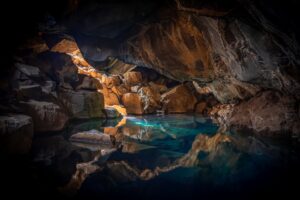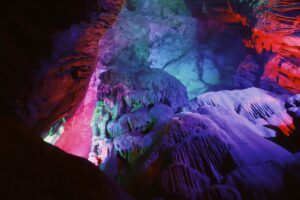Yellowstone National Park Maps
Yellowstone National Park Maps
WhiteClouds builds 3D Raised Relief Maps
Did you know we make
3D raised-relief maps
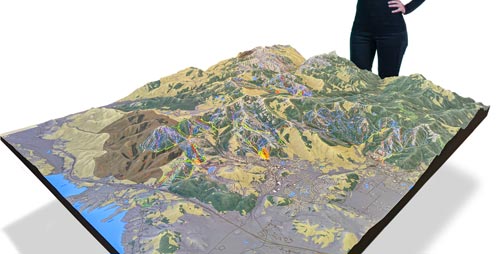
and
3D raised-relief maps
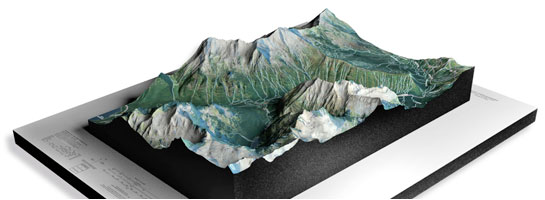
Yellowstone National Park is a wonderland of natural beauty, spanning over 2.2 million acres of breathtaking landscape in the western United States. From its awe-inspiring geysers to its stunning wildlife, Yellowstone is a paradise for nature lovers and adventurers alike. But with so much to see and explore, it can be overwhelming to plan your trip without proper guidance. That’s where Yellowstone National Park maps come in.
With over 100 different Yellowstone National Park maps available, these maps provide an essential resource for anyone looking to experience the park to its fullest potential. Whether you’re planning a hike through the backcountry, searching for the perfect campsite, simply trying to navigate the park’s winding roads, or capturing mementos from your vacation, there’s a map for every need.
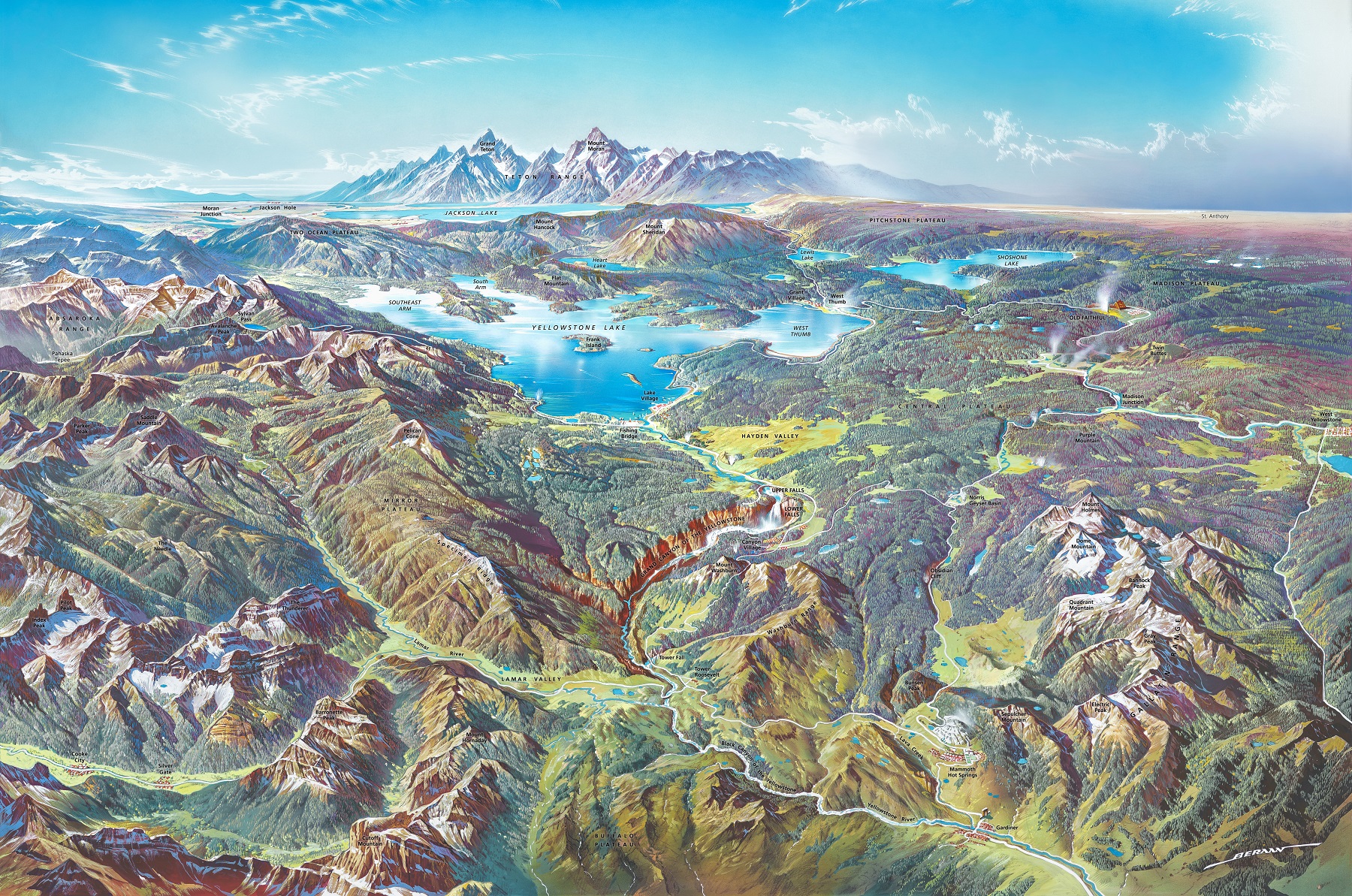
Yellowstone maps come in a variety of formats, from traditional topographic maps to artistic renderings and 3D models. For those interested in the park’s unique geology, geological maps provide detailed information about the park’s numerous hot springs, geysers, and other volcanic features. Meanwhile, trail maps offer valuable information about the park’s vast network of hiking trails, including distances, elevations, and difficulty ratings. Or, how about a unique map that provides detailed information on the park’s wildlife, including where to find different species, their habits and behaviors, and the best times to view them.
If you’re planning a visit to a Top 10 Yellowstone National Park, a good map can make all the difference. So whether you’re an experienced outdoors enthusiast or a first-time visitor, be sure to pack a few Yellowstone maps and get ready for the adventure of a lifetime.
Check out our many various maps of Yellowstone National Park and let the adventure begin!
Yellowstone 3D Maps
Yellowstone Backcountry Maps
Yellowstone Brochure Maps
Yellowstone Campground Maps
Yellowstone Climate Maps
Yellowstone Contour Maps
Yellowstone Destination Maps
Yellowstone Elevation Maps
Yellowstone Geologic Maps
Yellowstone Historical Maps
Yellowstone Lodging Maps
Yellowstone Road Maps
Yellowstone Satellite Maps
Yellowstone Terrain Maps
Yellowstone Topographic Maps
Yellowstone Trail Maps
Yellowstone USGS Maps
Yellowstone Weather Maps
Yellowstone Wildlife Maps
Yellowstone National Park 3D Maps
Yellowstone National Park is a wonderland of natural beauty, with its vast and intricate landscape, breathtaking geothermal features, and diverse wildlife. One of the most exciting tools available for exploring Yellowstone is its 3D maps.
First, let’s consider the benefits of 3D maps. Unlike traditional maps, which are typically flat and two-dimensional, 3D maps provide a more immersive and interactive experience. They allow you to explore Yellowstone’s landscape from all angles, getting a better sense of its contours, elevations, and depths. This can be particularly useful for hikers and backpackers who need to plan their routes carefully and avoid potential hazards.
- To learn how Yellowstone National Park 3D maps are built, click here: 3D Satellite Maps or 3D USGS Maps
- Yellowstone National Park 3D Maps-3D Raised Relief
One of the most impressive 3D maps available for Yellowstone is the Yellowstone National Park 3D Topographic Map. This map uses advanced satellite imagery and elevation data to create a stunningly detailed and accurate representation of the park’s landscape. It shows the park’s mountains, canyons, rivers, and lakes in stunning detail, allowing visitors to explore Yellowstone’s terrain in a way that was never before possible.
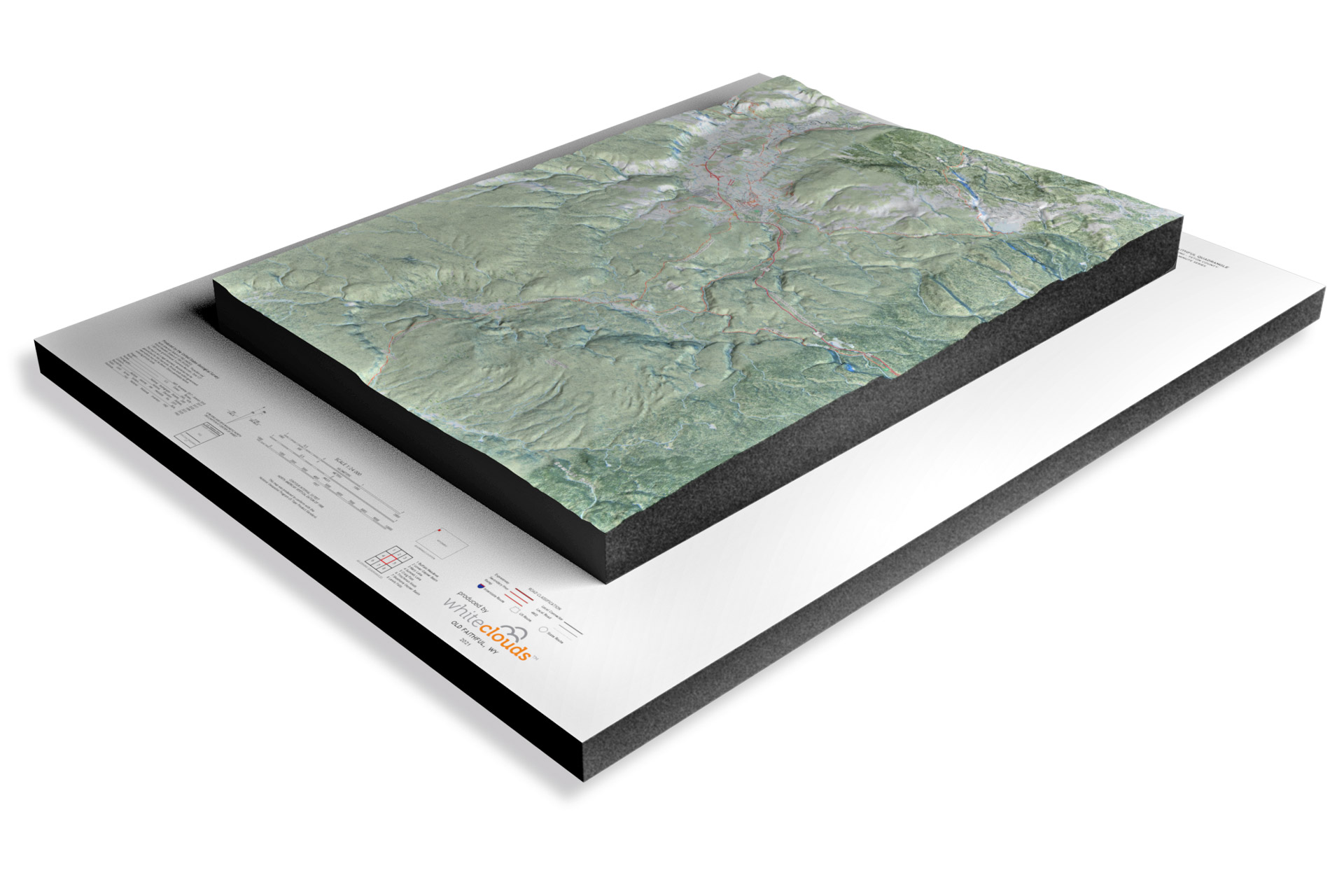
Another exciting 3D map available for Yellowstone is the Yellowstone Geologic 3D Map. This map provides a detailed look at the park’s geology and volcanic history, using 3D modeling and animations to bring this complex subject to life. It shows the park’s famous geothermal features, such as Old Faithful and the Grand Prismatic Spring, in incredible detail, allowing visitors to see how these natural wonders have been shaped by the forces of nature.
Perhaps the most impressive aspect of 3D maps is their ability to enhance the visitor experience. By providing a more immersive and interactive way of exploring Yellowstone, these maps can help visitors connect more deeply with the park’s natural beauty and understand its unique features in a more profound way. They can also help visitors plan their trips more effectively, ensuring that they make the most of their time in this incredible national park.
Yellowstone National Park Backcountry Maps
Yellowstone National Park is known for its stunning natural beauty, and much of that beauty can be found in its vast backcountry. The park offers over 2 million acres of pristine wilderness, with countless trails, campsites, and natural wonders waiting to be explored. To navigate this vast and wild landscape, visitors rely on Yellowstone backcountry maps.
Yellowstone backcountry maps are essential for any visitor looking to venture beyond the park’s roads and developed areas. These maps provide detailed information on trails, campsites, natural features, and other important landmarks, allowing visitors to plan their route and safely navigate the park’s backcountry.
- To learn how 2D/3D backcountry maps are built, click here: Satellite Maps
- Yellowstone Backcountry Trails and Campsite Maps-National Park Service
One of the most popular backcountry destinations in Yellowstone is the Thorofare region, which is the park’s most remote and isolated area. This region is home to abundant wildlife, including grizzly bears, wolves, elk, and bison. Visitors who venture into the Thorofare region often use backcountry maps to plan their route and stay safe.
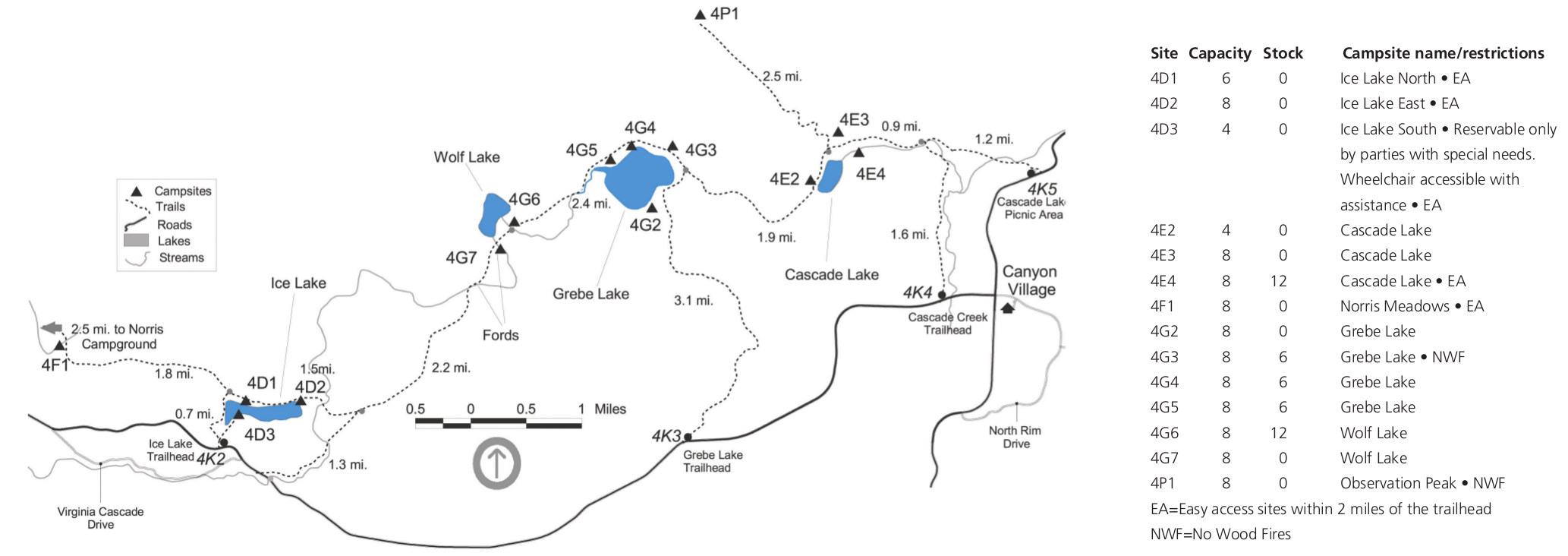
Yellowstone backcountry maps also provide valuable information on regulations and restrictions within the park’s wilderness areas. For example, visitors are required to obtain a backcountry permit before embarking on a backcountry trip, and must follow strict guidelines on food storage, campsite selection, and waste disposal. Backcountry maps help visitors understand and comply with these regulations, ensuring a safe and enjoyable trip for all.
In addition to their practical uses, Yellowstone backcountry maps also offer a glimpse into the park’s natural and cultural history. The maps include information on the geology, wildlife, and human history of the area, providing a fascinating backdrop to any backcountry adventure.
Yellowstone National Park Brochure Maps
Yellowstone National Park is a vast and complex landscape, with diverse attractions and activities for visitors to enjoy. To help visitors navigate and plan their trip, the park offers a variety of brochure maps.
Brochure maps are a convenient and easy-to-use tool for visitors to Yellowstone. These maps are typically included in the park’s official brochure or visitor guide and provide an overview of the park’s attractions, facilities, and services. They are designed to be user-friendly and informative, providing visitors with the information they need to plan their trip and make the most of their time in the park.
- To learn how 2D/3D brochure maps are built, click here: Satellite Maps
- Yellowstone National Park Maps-Canvas Prints
- Yellowstone National Park 3D Maps-3D Raised Relief
- Yellowstone National Park Maps-National Park Service
One of the most impressive brochure maps available for Yellowstone is the Yellowstone National Park Map & Guide. This guide provides a detailed overview of the park’s attractions, including its geothermal features, wildlife, and historic sites. It also includes information on hiking trails, camping facilities, and other practical information that visitors need to know. The map is easy to read and provides a clear overview of the park’s geography and layout.
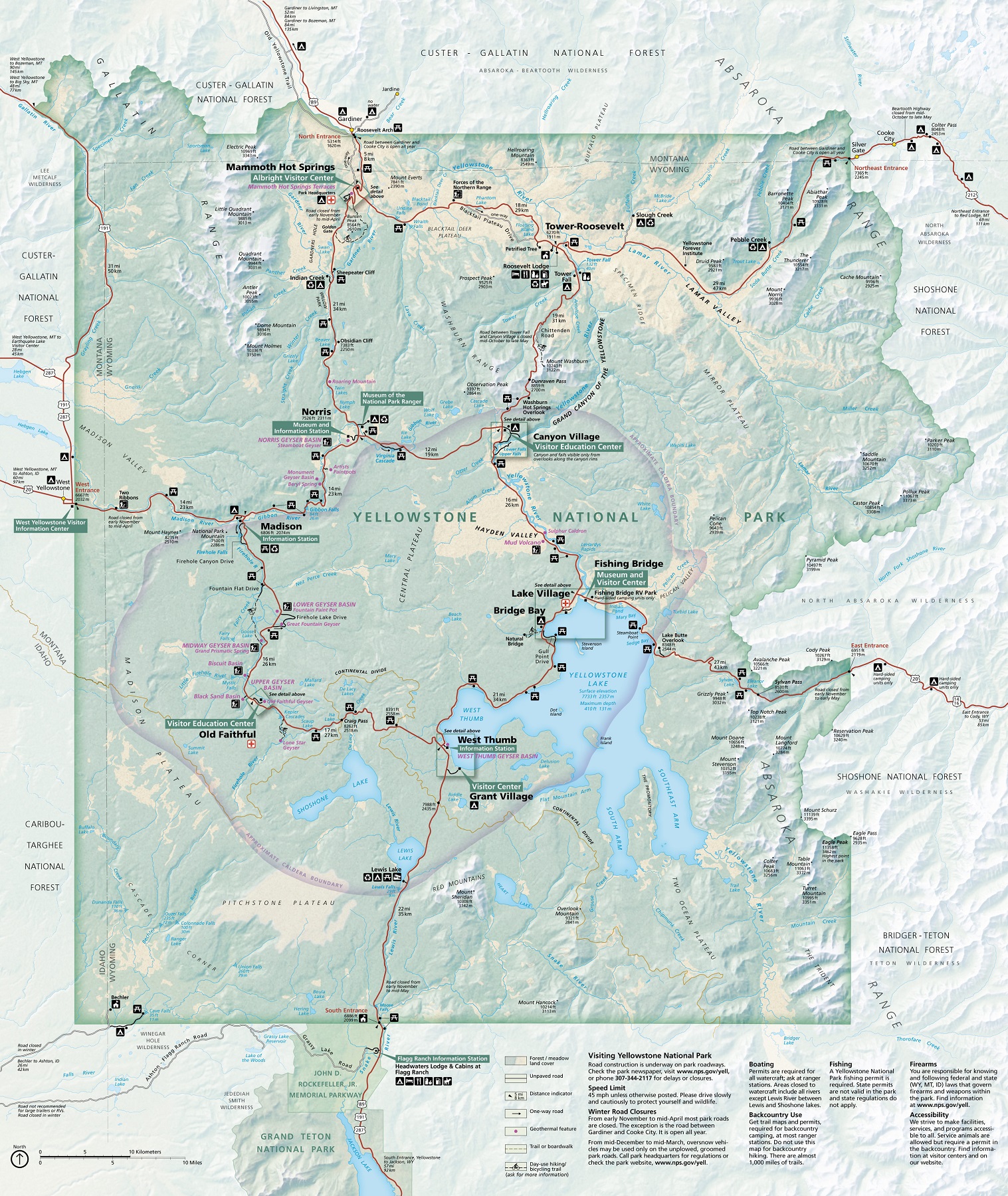
Another notable brochure map available for Yellowstone is the Yellowstone Backcountry Trip Planner. This brochure provides information on backcountry camping and hiking in Yellowstone, including trail maps, permits, and safety information. It is a valuable tool for visitors who want to explore the park’s remote and less-traveled areas.
Perhaps the most impressive aspect of brochure maps is their ability to provide visitors with a comprehensive overview of the park’s attractions and facilities. By combining practical information with detailed maps, these brochures can help visitors plan their trip and make the most of their time in Yellowstone.
Yellowstone National Park Campground Maps
Yellowstone National Park is home to some of the most stunning natural landscapes and wildlife in the world, making it a popular destination for camping enthusiasts. To help visitors plan their camping trips, the park offers a variety of campground maps.
Yellowstone National Park has 12 campgrounds, each with its unique features and amenities. These campgrounds range from primitive backcountry sites to more developed campsites with modern amenities such as electricity, water, and dump stations. To help visitors navigate and plan their camping trip, each campground offers a detailed campground map.
- To learn how 2D/3D lodging maps are built, click here: Terrain Maps
- Yellowstone National Park-Campground Maps
One of the most impressive campground maps available for Yellowstone is the Madison Campground Map. This map provides visitors with a detailed overview of the campground’s layout, including the location of campsites, restrooms, and other facilities. The map also provides useful information on the campground’s amenities, including its proximity to nearby attractions and hiking trails.
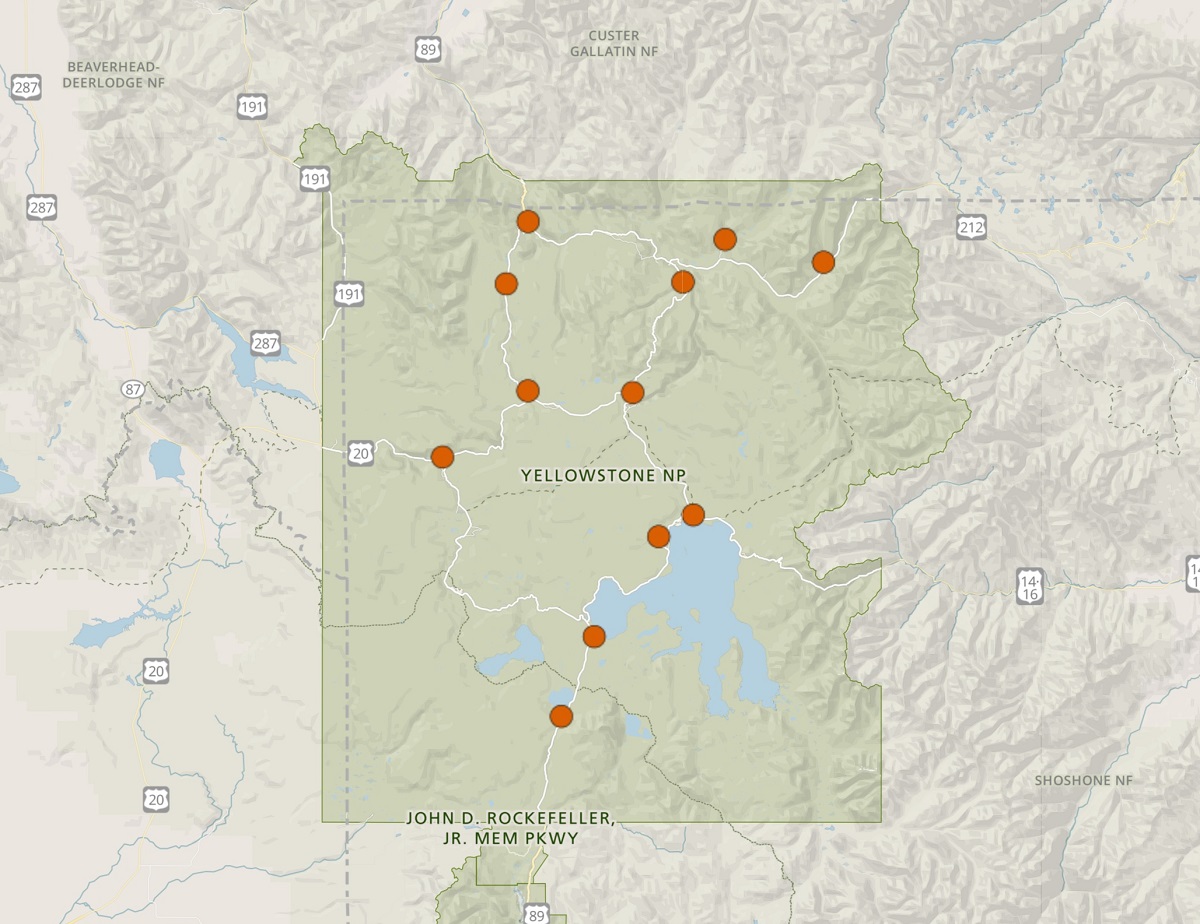
Another notable campground map available for Yellowstone is the Bridge Bay Campground Map. This map features a detailed layout of the campground, including the location of campsites, restrooms, and showers. The map also provides information on the campground’s amenities, including its proximity to the lake and marina.
Perhaps the most impressive aspect of campground maps is their ability to provide visitors with a clear and detailed overview of the campground’s facilities and amenities. By combining practical information with detailed maps, these campground maps can help visitors plan their camping trip and make the most of their time in Yellowstone.
Yellowstone National Park Climate Maps
Yellowstone National Park is a vast and diverse landscape, with varied climates and weather patterns depending on the location and time of year. Yellowstone has a unique climate due to its high elevation and location in the Rocky Mountains. The park experiences four distinct seasons, each with its unique weather patterns and temperature ranges.
- To learn how 2D/3D climate maps are built, click here: Satellite Maps
- Yellowstone National Park Climate Maps-NPS Climate Explorer
- Wyoming Climate Maps-NOAA Climate Maps (National Oceanic and Atmospheric Administration)
One of the most impressive climate maps available for Yellowstone is the Average Temperature and Precipitation Map. This map provides visitors with a detailed overview of the park’s temperature and precipitation patterns throughout the year. It includes a color-coded legend that shows the average temperature and precipitation for each month, making it easy for visitors to plan their trip around the weather. The Yellowstone National Parks Climate Explorer is available here:
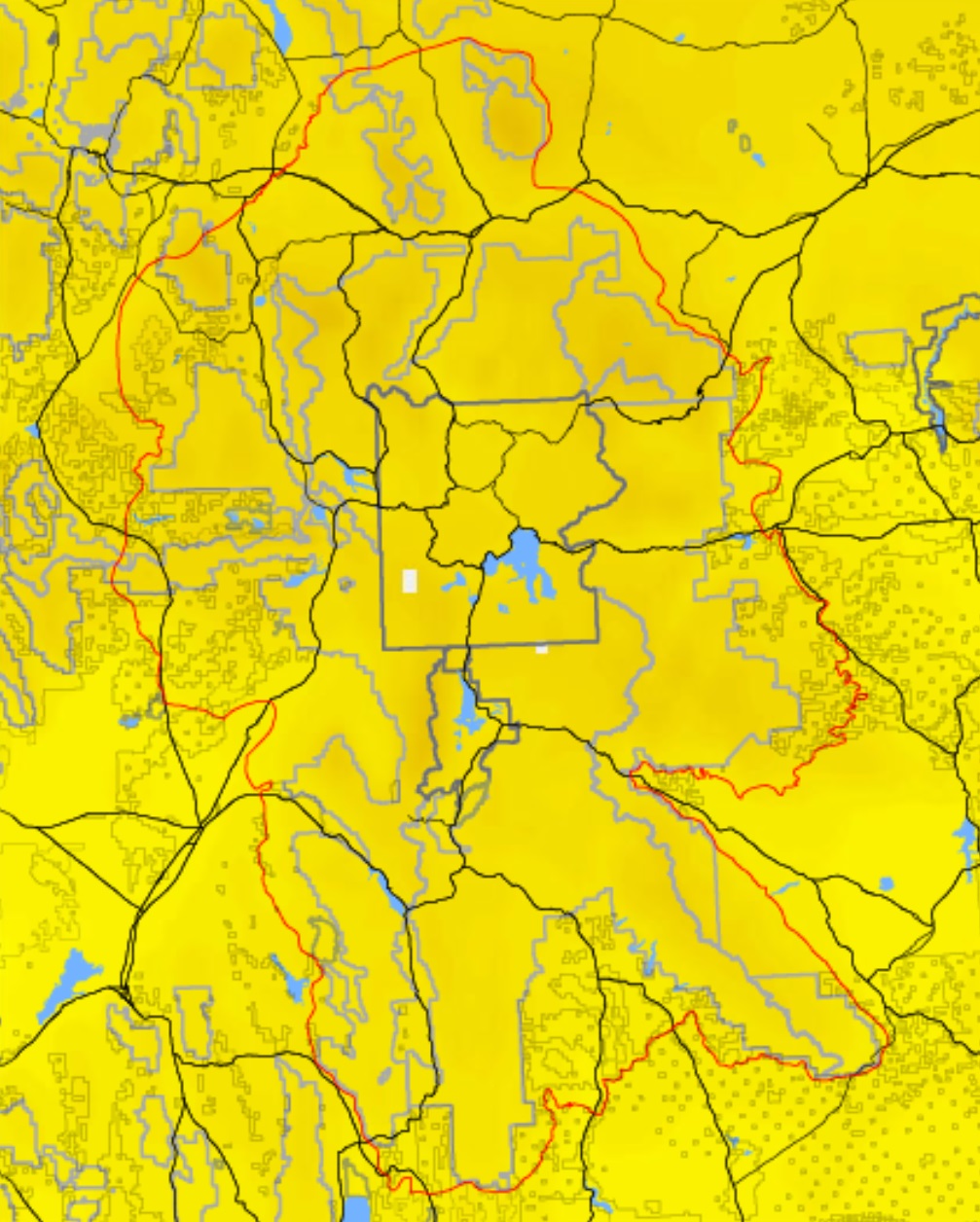
Another notable climate map available for Yellowstone is the Snow Depth Map. This map provides visitors with real-time information on the depth of snow throughout the park, which can be especially important for winter activities such as cross-country skiing and snowmobiling. The map also includes information on road closures and other winter weather advisories.
Perhaps the most impressive aspect of climate maps is their ability to provide visitors with a comprehensive understanding of the weather patterns and temperature ranges in Yellowstone. By combining practical information with detailed maps, these climate maps can help visitors plan their trip and prepare for the weather.
Yellowstone National Park Contour Maps
Yellowstone National Park is renowned for its stunning natural beauty and diverse landscapes, including towering mountains, sweeping valleys, and winding rivers. Contour maps are a type of topographic map that uses contour lines to depict the shape and elevation of the land. In Yellowstone, contour maps are particularly useful for hikers and backpackers, as they can provide a detailed overview of the park’s terrain and help visitors plan their routes.
- To learn how 2D/3D contour maps are built, click here: Contour Maps
- Yellowstone National Park Maps-Canvas Prints
- Wyoming Contour Maps-Canvas Prints
- Yellowstone National Park 3D Maps-3D Raised Relief
- Wyoming Contour 3D Maps-3D Raised Relief
One of the most impressive contour maps available for Yellowstone is the Mount Washburn Trail Map. This map provides visitors with a detailed overview of the Mount Washburn trail, which is one of the park’s most popular hiking routes. The map includes contour lines that depict the elevation of the mountain, as well as information on the trail’s distance, difficulty, and notable landmarks.
Another notable contour map available for Yellowstone is the Grand Loop Road Map. This map provides visitors with a comprehensive overview of the park’s main road, including information on the road’s elevation, curves, and notable landmarks. The map also includes information on the park’s campgrounds, visitor centers, and other points of interest.
Perhaps the most impressive aspect of contour maps is their ability to provide visitors with a detailed understanding of the park’s terrain and elevation. By combining practical information with detailed maps, these contour maps can help visitors plan their routes and make the most of their time in Yellowstone.
Yellowstone National Park Destination Maps
Yellowstone National Park is a vast and diverse landscape, with numerous destinations and points of interest scattered throughout its expansive terrain. To help visitors explore and discover these destinations, the park offers a variety of destination maps.
Destination maps are a type of map that highlights the park’s various destinations and points of interest, such as geysers, hot springs, waterfalls, and hiking trails. These maps are particularly useful for visitors who want to explore the park’s many attractions and make the most of their time in Yellowstone.
- To learn how 2D/3D destination maps are built, click here: Terrain Maps
- Yellowstone National Park-Plan Your Visit
One of the most impressive destination maps available for Yellowstone is the Old Faithful Area Map. This map provides visitors with a comprehensive overview of the Old Faithful area, which is one of the park’s most popular destinations. The map includes information on the geyser’s eruption schedule, as well as information on nearby trails, visitor centers, and other points of interest.
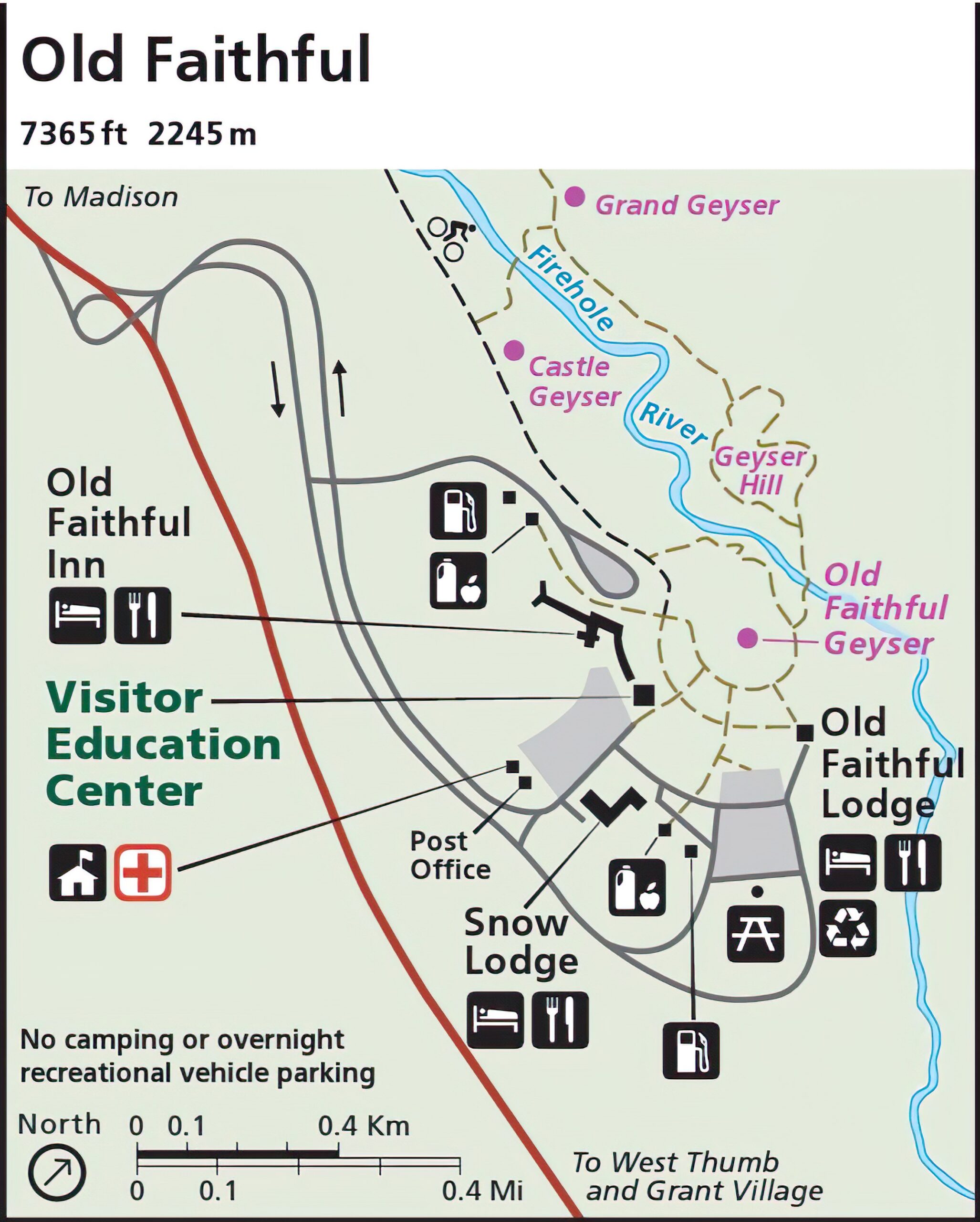
Another notable destination map available for Yellowstone is the Canyon Area Map. This map provides visitors with a detailed overview of the park’s Canyon area, which is renowned for its stunning waterfalls and dramatic landscapes. The map includes information on the park’s numerous hiking trails, as well as information on nearby campgrounds and lodging options.
Perhaps the most impressive aspect of destination maps is their ability to provide visitors with a comprehensive overview of the park’s various attractions and points of interest. By combining practical information with detailed maps, these destination maps can help visitors plan their itinerary and make the most of their time in Yellowstone.
Yellowstone National Park Elevation Maps
Yellowstone National Park is home to a wide range of elevations, from deep valleys and winding rivers to towering mountains and sweeping plateaus. Elevation maps are a type of map that uses contour lines to depict the shape and elevation of the land. In Yellowstone, elevation maps are particularly useful for hikers and backpackers, as they can provide a detailed overview of the park’s terrain and help visitors plan their routes.
First, let’s talk about what an elevation map is. An elevation map is a type of topographic map that shows the heights and depths of various landforms in a particular area. These maps use contour lines to indicate the elevation of different parts of the terrain. These lines are often color-coded to show the different elevations.
- To learn how 2D/3D elevation maps are built, click here: Elevation Maps
Now, let’s talk about the colors. The colors used on Yellowstone’s elevation maps are not just random. They are chosen carefully to represent different elevations. The lowest elevations are usually represented by shades of green, while higher elevations are represented by shades of brown and orange. The highest elevations, which can be found in the Absaroka Range, are represented by shades of blue and purple.
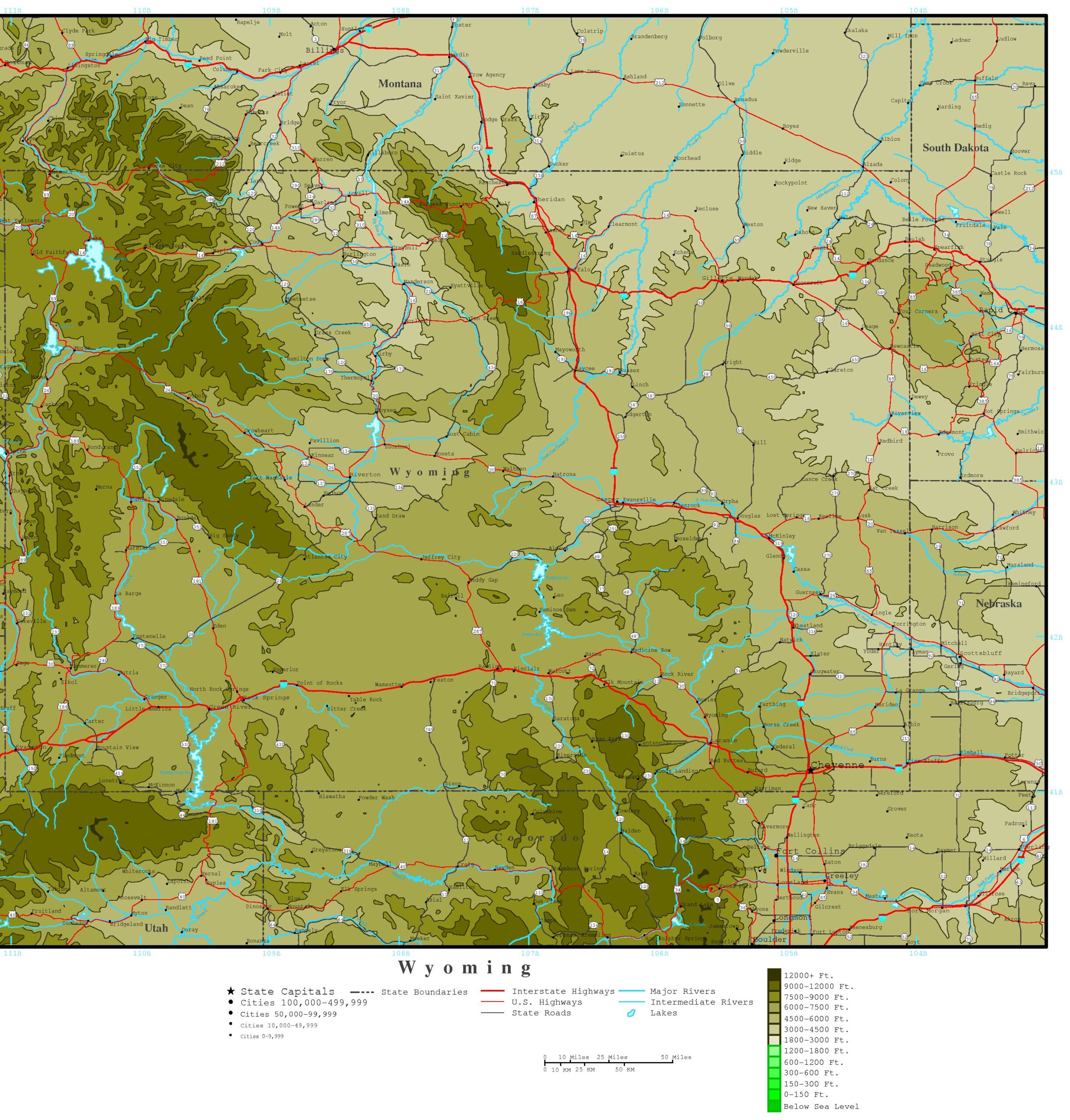
The colors used on the elevation maps of Yellowstone not only represent different elevations, but they also create a visually stunning image of the park’s topography. The colors help visitors to better understand the lay of the land, and they also add to the park’s overall beauty.
The colors used on Yellowstone’s elevation maps are not just for aesthetic purposes. They also serve a functional purpose. The colors help hikers and backpackers to navigate the park’s rugged terrain. By looking at the colors on the map, they can determine the best route to take based on the terrain’s elevation.
Yellowstone National Park Geologic Maps
Yellowstone National Park is famous for its geothermal features, including geysers, hot springs, and mud pots. But the park is also home to a fascinating geological history, shaped by volcanic activity and tectonic forces over millions of years.
Geologic maps are a type of map that depicts the geological features of a given area, including rock formations, faults, and other geological features. In Yellowstone, geologic maps are particularly useful for visitors who want to learn more about the park’s geological history and how it has shaped the park’s unique landscapes.
- To learn how 2D/3D geology maps are built, click here: Geologic Maps
- Yellowstone National Park Geologic Maps: National Geologic Database
One of the most impressive geologic maps available for Yellowstone is the Geologic Map of the Yellowstone National Park Area. This map provides visitors with a comprehensive overview of the park’s geologic history, including information on its volcanic past, tectonic activity, and other geological features. The map includes detailed depictions of the park’s many geothermal features, as well as information on nearby hiking trails and other points of interest.

Another notable geologic map available for Yellowstone is the West Thumb Geyser Basin Geologic Map. This map provides visitors with a detailed overview of the geologic history of the West Thumb Geyser Basin, which is one of the park’s most popular geothermal attractions. The map includes detailed depictions of the basin’s many geothermal features, as well as information on nearby hiking trails and other points of interest.
Perhaps the most impressive aspect of geologic maps is their ability to provide visitors with a deeper understanding of the park’s geological history and how it has shaped the park’s unique landscapes. By combining practical information with detailed maps, these geologic maps can help visitors appreciate the incredible natural forces that have shaped Yellowstone over millions of years.
Yellowstone National Park Historical Maps
Yellowstone National Park has a rich and fascinating history, from its early use by Native American tribes to its establishment as the world’s first national park in 1872.
Historical maps are a type of map that depicts the historical features of a given area, including landmarks, routes, and other important features from the past. In Yellowstone, historical maps are particularly useful for visitors who want to learn more about the park’s rich history and how it has shaped the park’s unique landscapes.
- To learn how 2D/3D historical maps are built, click here: USGS Historical Maps
- Yellowstone National Park Historical Maps-Library of Congress
One of the most impressive historical maps available for Yellowstone is the Yellowstone National Park Historical Map. This map provides visitors with a comprehensive overview of the park’s history, including information on early explorers, the park’s establishment as a national park, and other important historical events. The map includes detailed depictions of the park’s many landmarks, as well as information on nearby hiking trails and other points of interest.
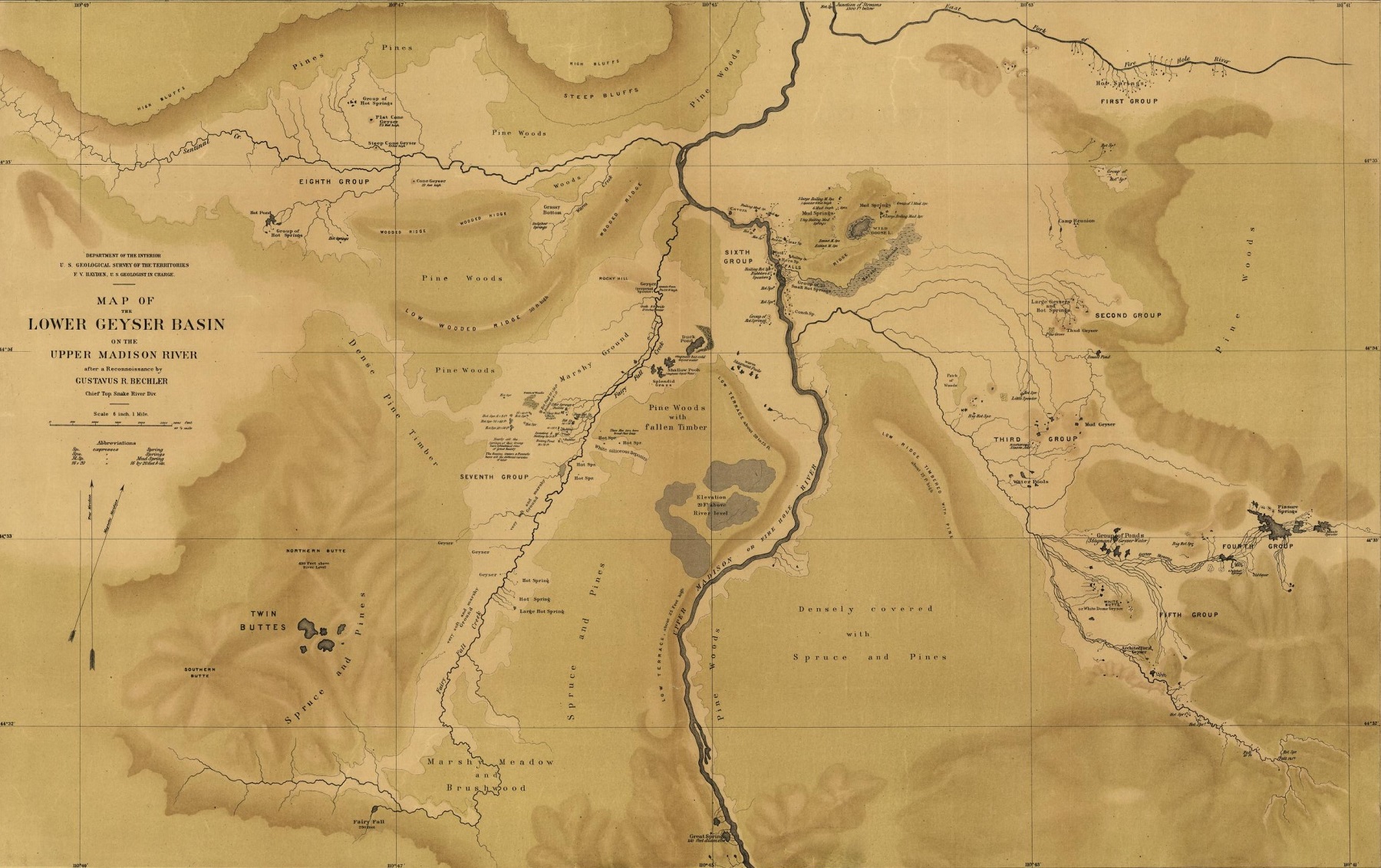
Another notable historical map available for Yellowstone is the Yellowstone Wagon Roads Historical Map. This map provides visitors with a detailed overview of the park’s wagon roads, which were an important transportation route in the park’s early history. The map includes detailed depictions of the park’s many wagon roads, as well as information on nearby historical landmarks and other points of interest.
Perhaps the most impressive aspect of historical maps is their ability to transport visitors back in time and help them appreciate the park’s rich history. By combining practical information with detailed maps, these historical maps can help visitors understand the park’s unique cultural heritage and how it has shaped the park’s landscapes over time.
Yellowstone National Park Lodging Maps
Yellowstone National Park is a massive and awe-inspiring destination, with a vast array of lodging options to choose from. To help visitors find the perfect place to stay during their trip, Yellowstone lodging maps provide detailed information on the park’s many lodging options, including hotels, lodges, cabins, and campsites.
One of the most significant benefits of using Yellowstone lodging maps is their ability to help visitors choose the best lodging option based on their needs and preferences. These maps provide information on the location, amenities, and price range of each lodging option, allowing visitors to easily compare and select the option that best fits their budget and preferences.
- To learn how 2D/3D lodging maps are built, click here: Terrain Maps
- Yellowstone National Park-Plan Your Lodging
Yellowstone lodging maps also provide information on the location and availability of each lodging option, making it easy for visitors to plan their stay and make reservations in advance. This can be especially important during peak season when lodging options can book up quickly.
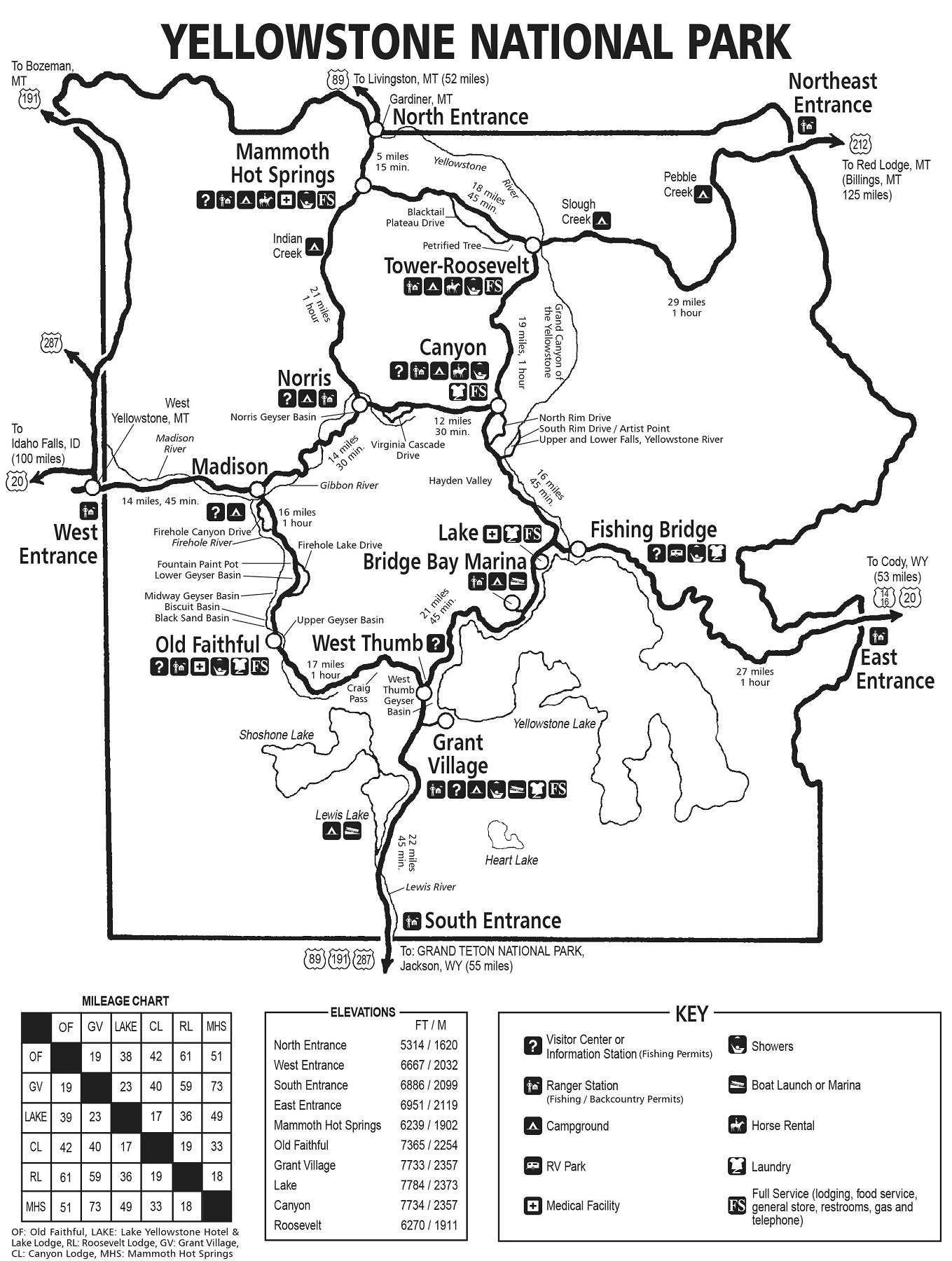
Another important benefit of using Yellowstone lodging maps is their ability to help visitors navigate the park and find their way to their chosen lodging option. These maps provide detailed information on the location and accessibility of each lodging option, allowing visitors to plan their route and find their way easily.
Yellowstone National Park Road Maps
Yellowstone National Park is an expansive and diverse destination that is best explored by car. To help visitors navigate the park’s many roads and highways, the park offers a variety of road maps.
Road maps are a type of map that provides detailed information on roads, highways, and other transportation routes in a given area. In Yellowstone, road maps are particularly useful for visitors who want to plan their travel routes, find the best scenic drives, and explore the park’s many attractions with ease.
- To learn how 2D/3D road maps are built, click here: Terrain Maps
- Yellowstone National Park-Plan Your Visit
- Yellowstone National Park-Official Park Road Map
One of the most impressive road maps available for Yellowstone is the Yellowstone National Park Road Map. This map provides visitors with a comprehensive overview of the park’s road network, including detailed depictions of the park’s many highways, roads, and other transportation routes. The map also includes information on nearby attractions, hiking trails, and other points of interest.
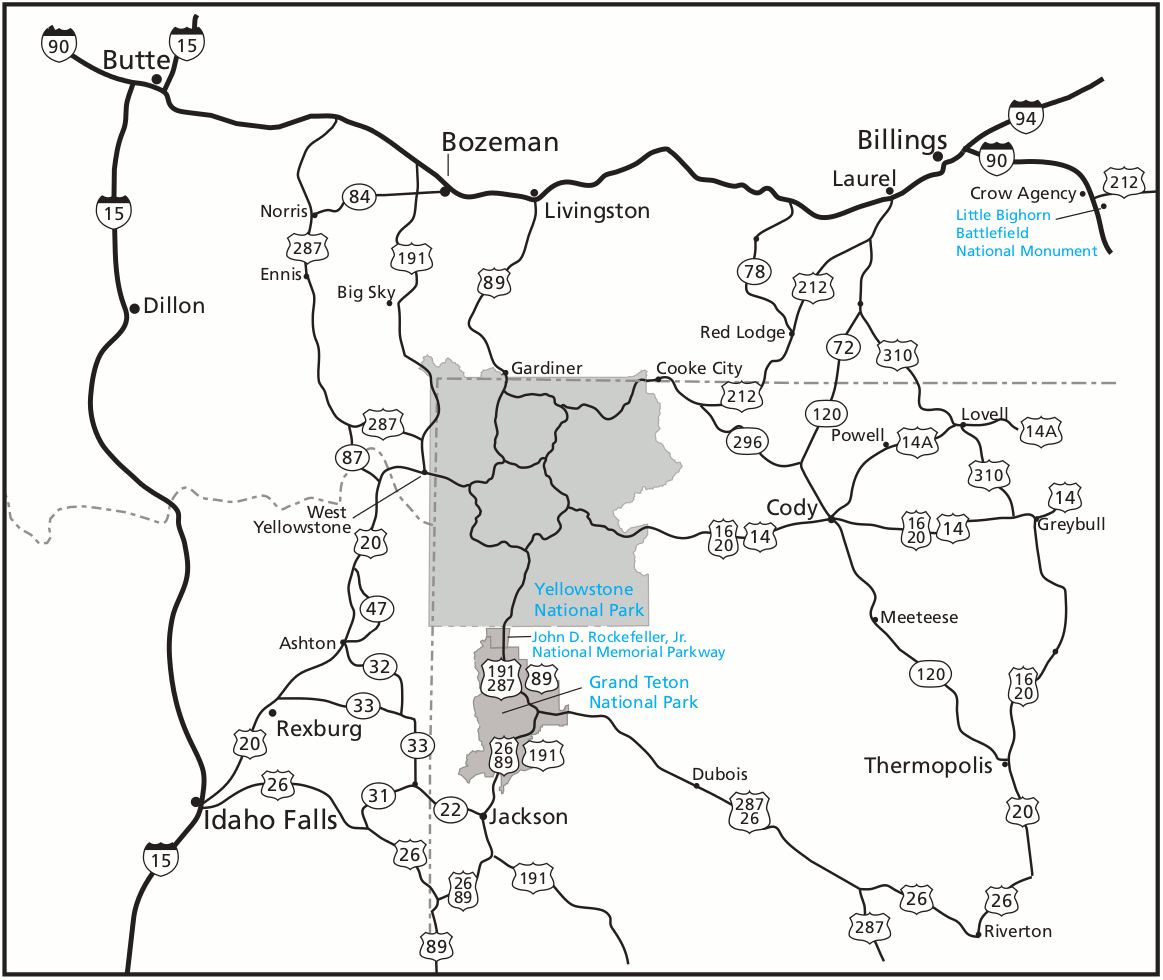
Another notable road map available for Yellowstone is the Yellowstone Scenic Byways Map. This map provides visitors with a detailed overview of the park’s most scenic drives, including the Beartooth Highway and the Chief Joseph Scenic Byway. The map includes information on nearby attractions, hiking trails, and other points of interest, making it the perfect tool for visitors who want to experience the park’s natural beauty from the comfort of their car.
Perhaps the most impressive aspect of road maps is their ability to help visitors plan their travel routes and make the most of their time in the park. By providing detailed information on the park’s many roads and highways, these maps can help visitors navigate the park’s expansive landscapes with ease.
Yellowstone National Park Satellite Maps
Yellowstone National Park is one of the most beautiful and geologically diverse areas in the world. One way to fully appreciate its beauty and vastness is through the use of satellite maps.
Satellite maps are a type of map that uses satellite imagery to provide a detailed view of the Earth’s surface. In Yellowstone, satellite maps are particularly useful for visitors who want to explore the park’s vast and rugged terrain. These maps provide a bird’s-eye view of the park, allowing visitors to see the park’s many geological formations, mountain ranges, and waterways.
- To learn how 2D/3D satellite maps are built, click here: Satellite Maps
- Yellowstone National Park Satellite Maps-Canvas Prints
- Wyoming Satellite Maps-Canvas Prints
- Yellowstone National Park 3D Satellite Maps-3D Raised Relief
- Wyoming Satellite 3D Satellite Maps-3D Raised Relief
- Yellowstone National Park Satellite Maps-Google Maps
One of the most impressive satellite maps available for Yellowstone is the Google Earth Yellowstone map. This map provides visitors with a 3D view of the park, allowing them to explore its many features in great detail. Visitors can zoom in on specific areas of the park and view it from any angle, making it the perfect tool for those who want to explore Yellowstone’s many hiking trails, hot springs, and other natural wonders.
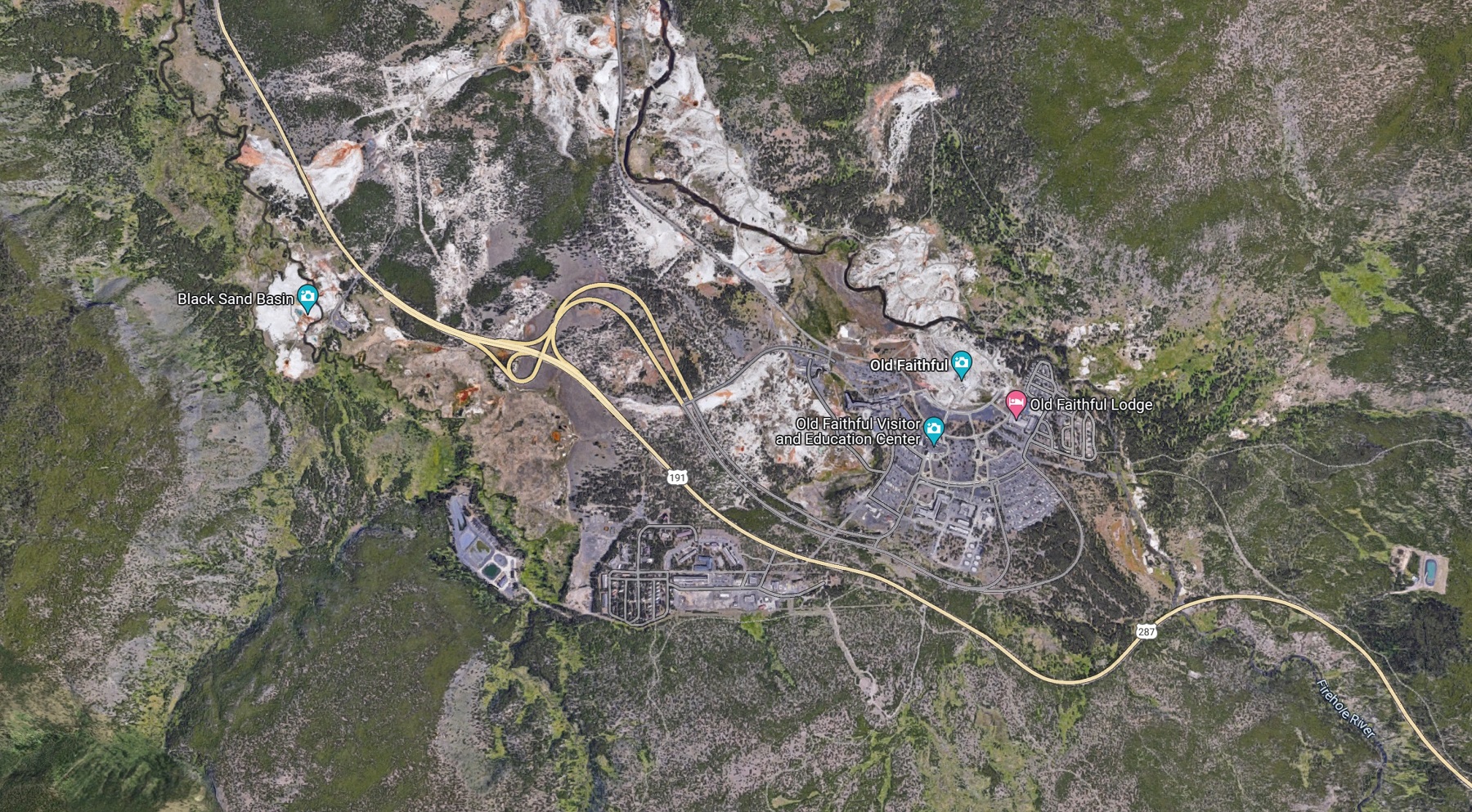
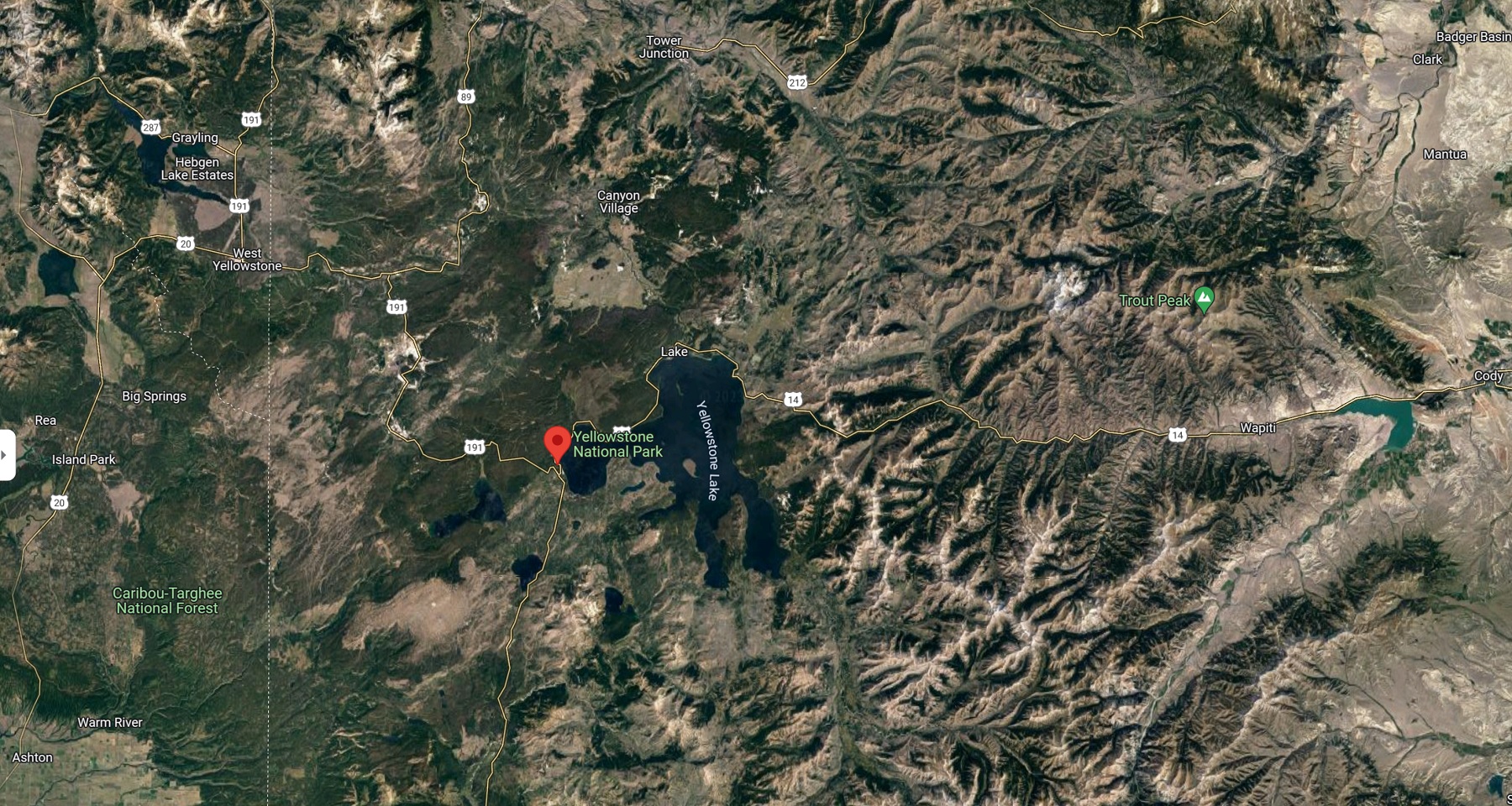
Another notable satellite map available for Yellowstone is the NASA Landsat satellite map. This map provides visitors with a more scientific view of the park, showing them how the park’s landscapes have changed over time. The map allows visitors to compare images of the park from different years, giving them a unique perspective on the park’s geology and ecology.
Perhaps the most impressive aspect of satellite maps is their ability to show visitors the park’s incredible size and scale. By providing a bird’s-eye view of the park, these maps can help visitors appreciate the park’s vastness and the incredible geological forces that shaped it.
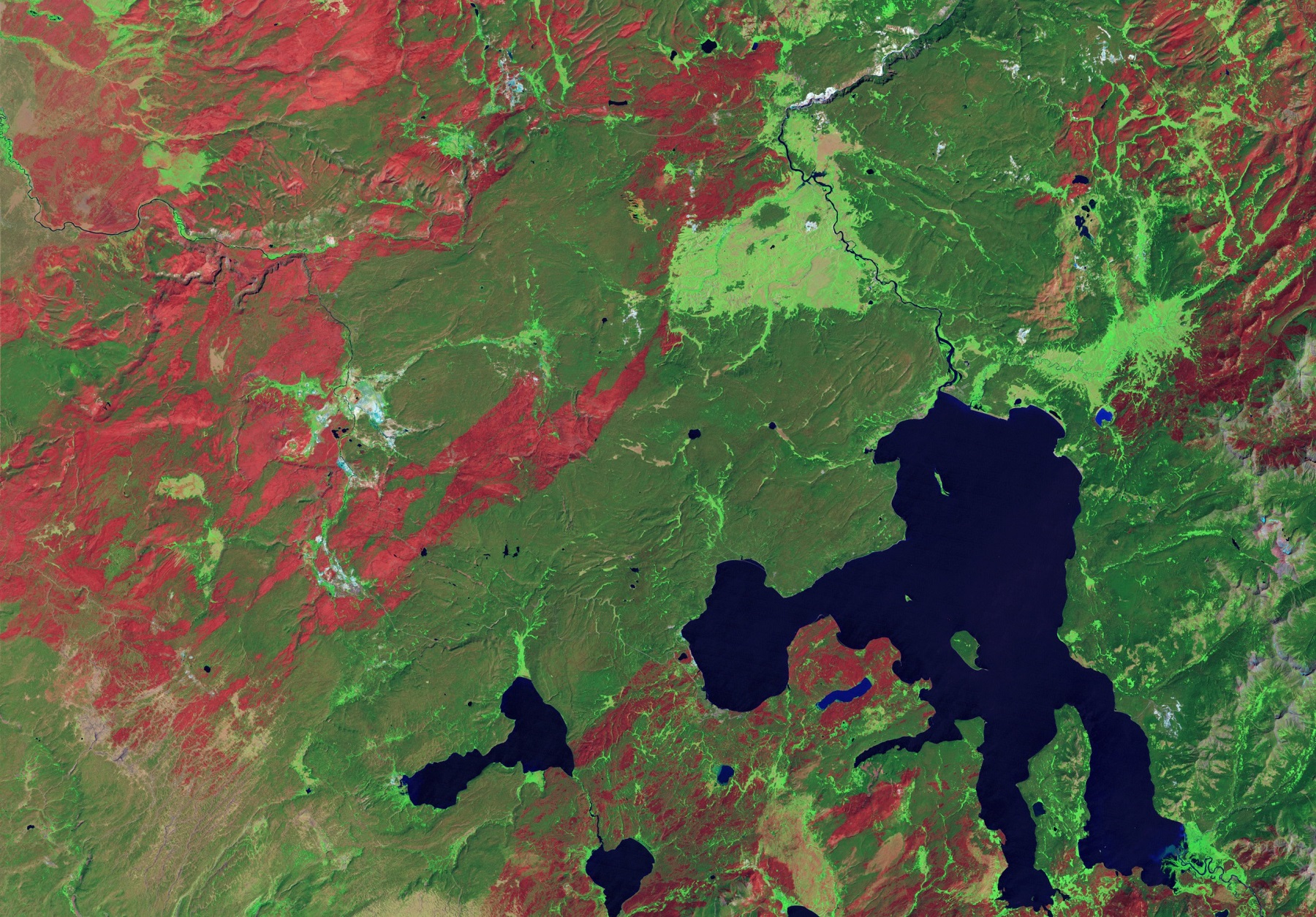
Yellowstone National Park Terrain Maps
Yellowstone National Park is home to some of the most rugged and diverse terrain in the world. From towering mountains and deep valleys to winding rivers and vast meadows, the park’s terrain is as varied as it is beautiful.
Terrain maps are a type of map that shows the physical characteristics of the Earth’s surface, including its elevation, slope, and topography. In Yellowstone, terrain maps are particularly useful for visitors who want to explore the park’s many hiking trails and natural wonders. These maps provide a detailed view of the park’s terrain, allowing visitors to plan their trips and navigate the park’s rugged terrain.
- To learn how 2D/3D terrain maps are built, click here: Terrain Maps
- Yellowstone National Park Terrain Maps-Canvas Prints
- Wyoming Terrain Maps-Canvas Prints
- Yellowstone National Park 3D Terrain Maps-3D Raised Relief
- Wyoming 3D Terrain Maps-3D Raised Relief
- Yellowstone National Park Terrain Maps-Google Maps
One of the most impressive terrain maps available for Yellowstone is the National Geographic Yellowstone Trails Illustrated Map. This map provides visitors with a detailed view of the park’s terrain, including its many mountains, valleys, and rivers. The map also includes information on the park’s hiking trails, backcountry campsites, and other natural features, making it the perfect tool for visitors who want to explore Yellowstone on foot.
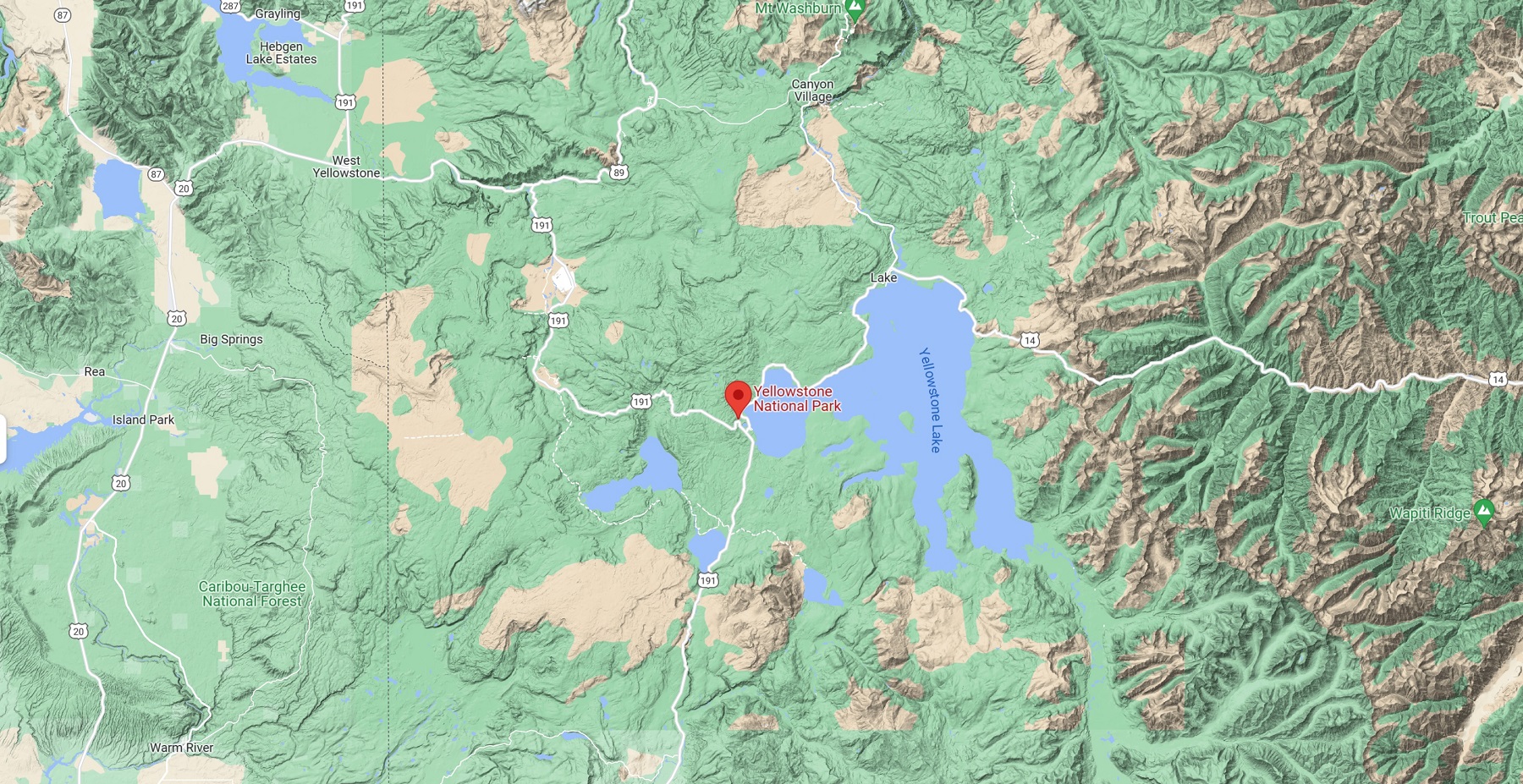
Another notable terrain map available for Yellowstone is the USGS Yellowstone topographic map. This map provides visitors with a more scientific view of the park’s terrain, showing them the park’s elevation, slope, and other physical characteristics in great detail. The map allows visitors to plan their trips and explore the park’s natural wonders with greater accuracy and precision.
Perhaps the most impressive aspect of terrain maps is their ability to show visitors the park’s incredible diversity. By providing a detailed view of the park’s terrain, these maps can help visitors appreciate the park’s vastness and the incredible geological forces that shaped it.
Yellowstone National Park Topographic Maps
Yellowstone National Park is a natural wonderland that boasts an incredible diversity of landscapes. From rugged mountains to meandering rivers, the park’s terrain is as varied as it is beautiful. Topographic maps are a valuable tool for exploring and understanding the park’s terrain.
Topographic maps are a type of map that shows the physical features of the Earth’s surface, including its elevation, and topographic relief. These maps use contour lines to show the height and shape of the land, making them an ideal tool for exploring the terrain of Yellowstone National Park. These maps are created using data collected through aerial photography, satellite imagery, and ground-based surveying techniques. The United States Geological Survey (USGS) is the primary agency responsible for creating and maintaining topographic maps for the entire country, including Yellowstone.
- To learn how 2D/3D topographic maps are built, click here: Topographic Maps
- Yellowstone National Park Topographic Maps-Canvas Prints
- Wyoming Topographic Maps-Canvas Prints
- Yellowstone National Park 3D Topographic Maps-3D Raised Relief
- Wyoming 3D Topographic Maps-3D Raised Relief
One of the most impressive topographic maps available for Yellowstone is the USGS Yellowstone topographic map. This map provides visitors with a detailed view of the park’s terrain, including its many mountains, valleys, and rivers. The map also shows the park’s elevation, making it easy to plan hiking and backpacking trips throughout the park.
Another aspect of topographic maps is their ability to provide visitors with a deeper understanding of the park’s geological history. By examining the contours of the land, visitors can gain a better appreciation for the incredible forces that shaped Yellowstone’s unique landscapes. From the volcanic activity that created the park’s hot springs and geysers to the glacial activity that carved the park’s valleys and canyons, topographic maps can help visitors explore and understand the park’s geological history.
Yellowstone National Park Trail Maps
Yellowstone National Park is a vast wilderness area that covers over 2 million acres of land. With such a vast expanse of wilderness to explore, it can be challenging for visitors to know where to start. That’s where trail maps come in handy.
Yellowstone trail maps provide visitors with a comprehensive view of the park’s hiking trails, backcountry campsites, and natural features. These maps are an invaluable tool for planning a hiking or backpacking trip in Yellowstone, as they can help visitors navigate the park’s many trails and plan a route that suits their interests and abilities.
- To learn how 2D/3D trail maps are built, click here: Terrain Maps
- Yellowstone National Park-Plan Your Visit
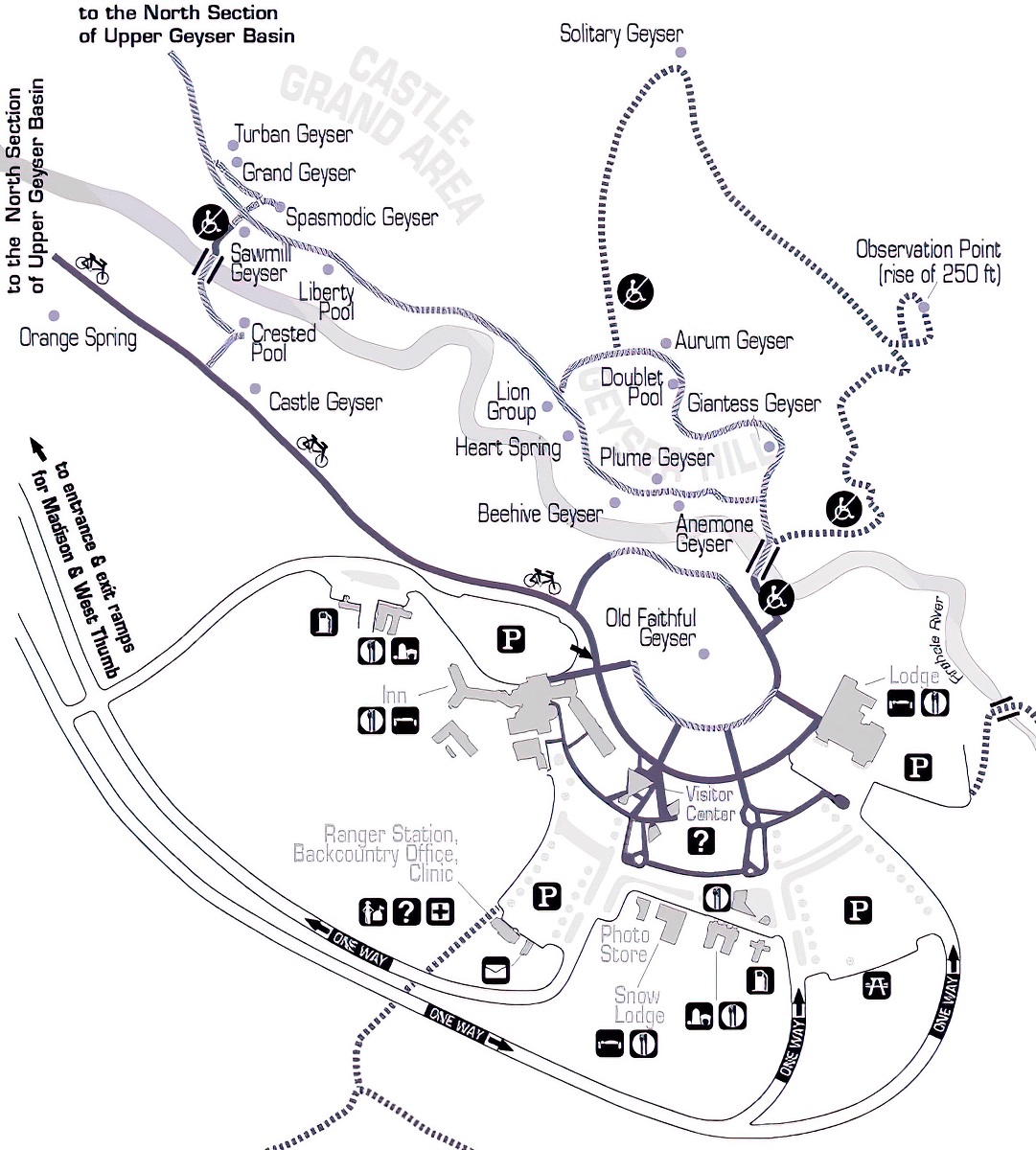
One of the most significant benefits of using Yellowstone trail maps is their ability to help visitors discover hidden gems within the park. With so many trails to choose from, it can be easy to stick to the most popular routes and miss out on some of the park’s lesser-known hiking trails and natural wonders. Trail maps can help visitors plan a route that takes them off the beaten path and allows them to explore some of the park’s hidden gems.
Yellowstone National Park USGS Maps
Yellowstone National Park is one of the most beautiful and unique places in the United States, home to an incredible array of geothermal features, wildlife, and natural wonders. To fully appreciate all that the park has to offer, visitors should consider using USGS maps, which provide detailed information on the park’s geology, topography, and other important features.
USGS maps are created by the United States Geological Survey, an agency responsible for mapping the country’s natural resources, hazards, and environmental health. In the case of Yellowstone National Park, USGS maps provide detailed information on the park’s geology, topography, hydrology, and more.
USGS maps are divided into quadrangles, each covering an area of 7.5 minutes of longitude and latitude. Each map provides detailed information on topography, including elevation contours, water features, and vegetation types. The maps also include roads, buildings, and other landmarks, allowing users to navigate and explore the landscape with precision.
- To learn how 2D/3D USGS maps are built, click here: USGS Maps and USGS Historical Maps
- Yellowstone National Park USGS Maps-Canvas Prints
- Wyoming USGS Maps-Canvas Prints
- Yellowstone National Park 3D USGS Maps-3D Raised Relief
- Wyoming 3D USGS Maps-3D Raised Relief
- Wyoming USGS Historical Topo 3D Maps by Cities-3D Raised Relief
Historical USGS maps of Yellowstone are also available and provide a fascinating glimpse into the area’s past. These maps were produced using traditional cartographic techniques, including photolithography and offset printing.
Yellowstone Historical USGS maps are valuable for a range of applications, including historical research, environmental assessment, and land use planning. They can provide information on changes in land use, including deforestation, urbanization, and agricultural development. They can also provide information on the natural features of the landscape, including wetlands, rivers, and other water bodies.
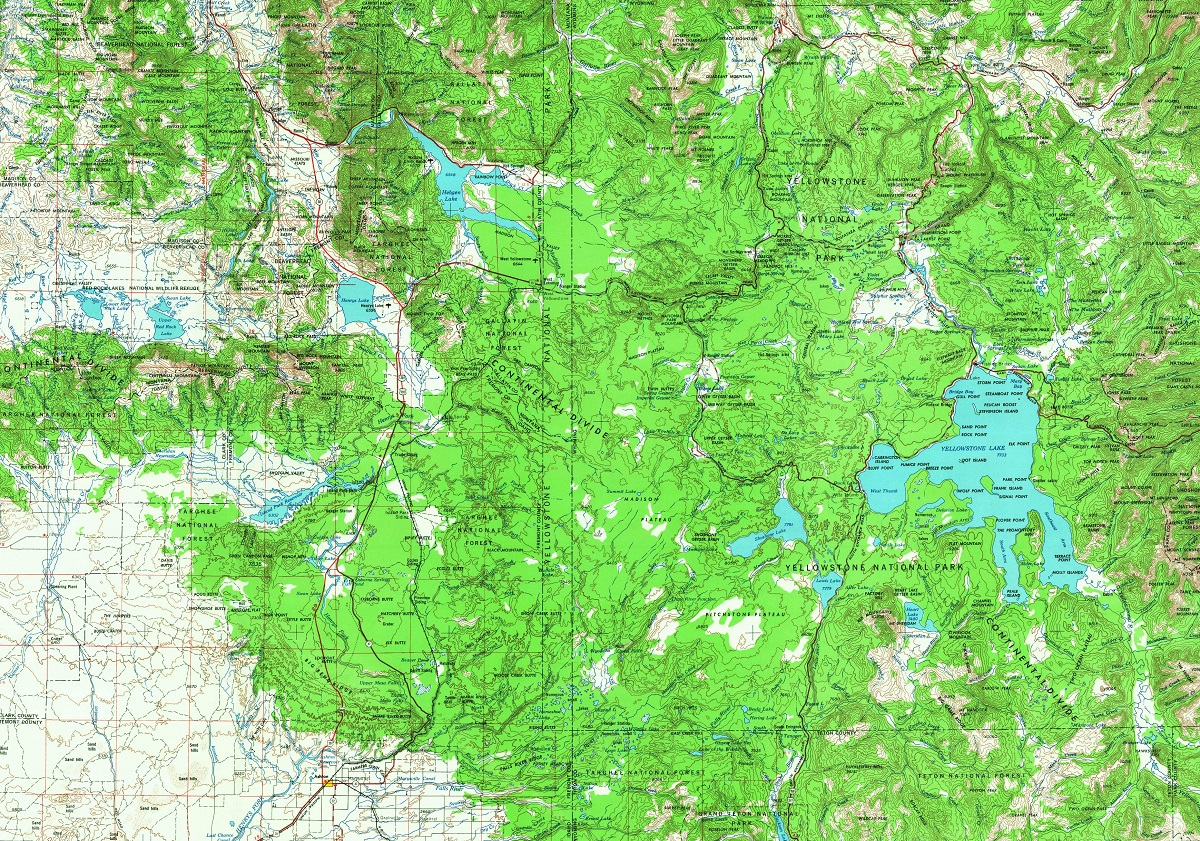
One of the most significant benefits of using Yellowstone USGS maps is their ability to help visitors understand the park’s unique geothermal features. Yellowstone is home to more than 10,000 hydrothermal features, including geysers, hot springs, mud pots, and fumaroles. USGS maps provide visitors with detailed information on the locations, names, and characteristics of these features, allowing them to better understand the park’s geological history and appreciate its natural beauty.
Another important benefit of using Yellowstone USGS maps is their ability to help visitors navigate the park’s many trails and backcountry areas. These maps provide information on trail locations, distances, elevations, and terrain, allowing visitors to plan their hikes and other outdoor activities safely and efficiently.
Yellowstone National Park Weather Maps
Yellowstone National Park is known for its dramatic landscapes, stunning natural features, and diverse wildlife. However, it is also notorious for its unpredictable and often severe weather.
Yellowstone weather maps provide visitors with up-to-date information on weather conditions in the park, including temperature, wind speed, precipitation, and more. These maps are an essential tool for planning a trip to Yellowstone, as they can help visitors prepare for the often-changing weather conditions that can occur in the park.
These maps are created and maintained by various government agencies, including the National Weather Service (NWS) and the National Oceanic and Atmospheric Administration (NOAA).
- To learn how 2D/3D weather maps are built, click here: NOAA Maps
- Yellowstone Current Weather Maps: National Park Service
- Yellowstone National Weather Service Forecast Maps
- Yellowstone Accuweather Maps
- Yellowstone Weather Forecast Maps
One of the most significant benefits of using Yellowstone weather maps is their ability to help visitors stay safe during their trip. Weather conditions in Yellowstone can change rapidly, and severe weather events such as lightning storms, blizzards, and flash floods can occur without warning. Weather maps can help visitors plan their activities around the weather and avoid potentially dangerous situations.
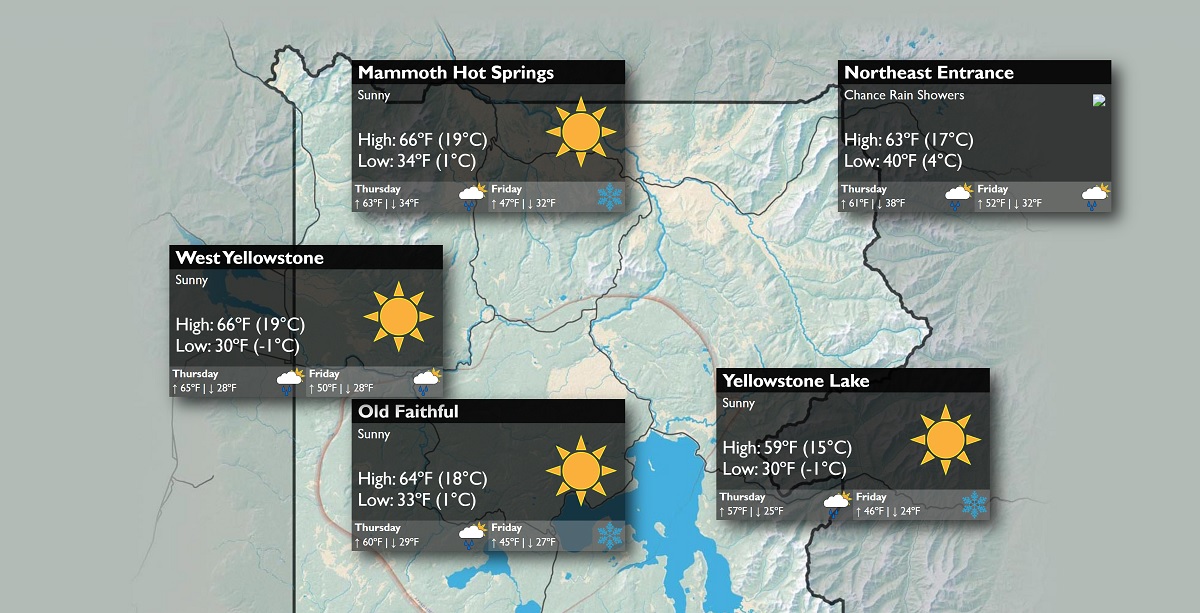
Another notable benefit of using Yellowstone weather maps is their ability to help visitors make the most of their trip. Weather conditions can have a significant impact on the park’s natural features, and knowing when and where to go can make all the difference in experiencing Yellowstone’s unique beauty. For example, a sunny day can bring out the vibrant colors of the park’s geothermal features, while a foggy morning can create a mystical atmosphere in the forests and valleys.
Yellowstone weather maps can be accessed through a variety of sources, including the National Park Service website, local weather stations, and weather apps such as AccuWeather and Weather Underground. These maps provide visitors with real-time data on weather conditions in the park, allowing them to make informed decisions about their activities and travel plans.
Yellowstone National Park Wildlife Maps
Yellowstone National Park is a sanctuary for a diverse range of wildlife species. With over 67 species of mammals, including grizzly bears, wolves, bison, elk, and more, it’s no wonder that the park is considered one of the best wildlife viewing destinations in the world. Yellowstone wildlife maps are an essential tool for anyone looking to explore the park’s incredible wildlife and experience the wonders of the natural world.
Yellowstone wildlife maps provide detailed information on the park’s different wildlife viewing areas, as well as the different species visitors can expect to see. These maps also provide information on the best times of day to view specific animals and where to find them, ensuring visitors have the best possible chance of seeing these incredible creatures in their natural habitat.
- To learn how 2D/3D wildlife maps are built, click here: Terrain Maps
- Yellowstone National Park-Watch Wildlife
One of the most iconic animals in Yellowstone is the bison, which can often be seen grazing on the park’s grasslands. Yellowstone wildlife maps provide information on the best areas to view bison, including the Lamar Valley, Hayden Valley, and the central plateau. These maps also provide information on the best times of day to view these magnificent animals, which are most active in the early morning and late afternoon.
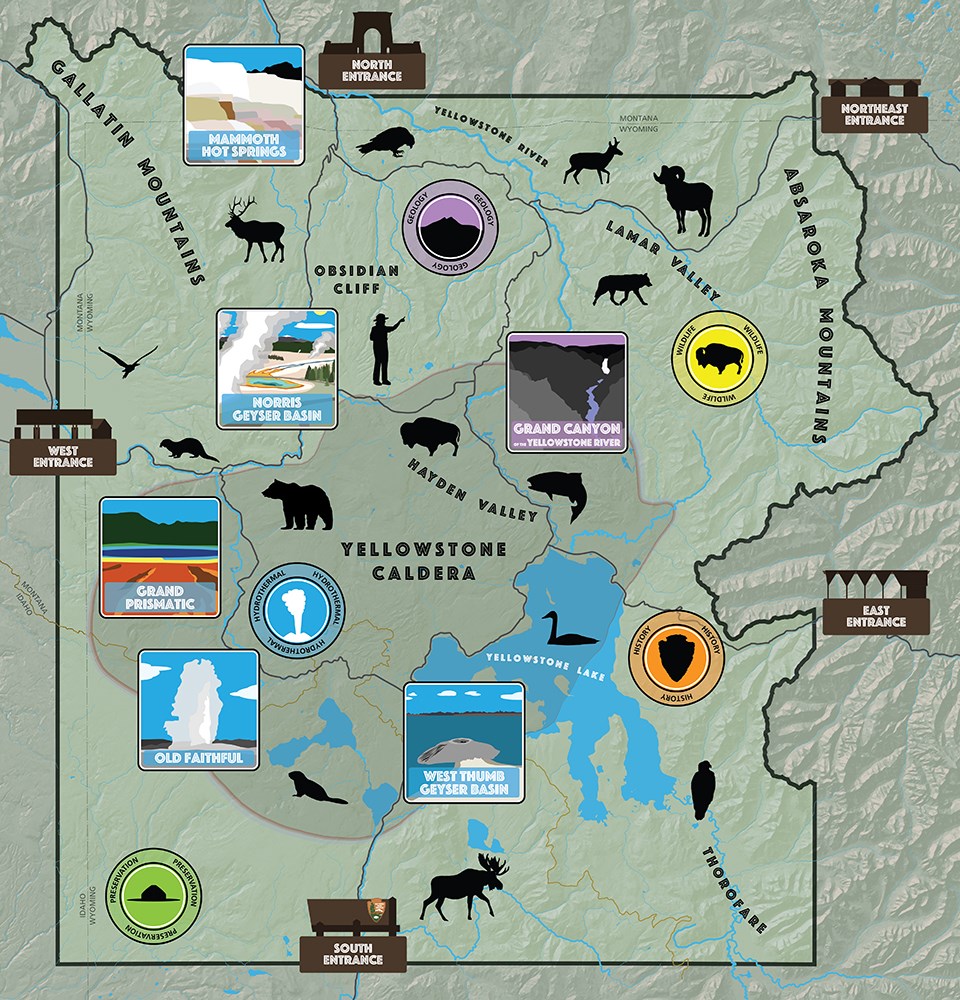
Another iconic Yellowstone animal is the grizzly bear, which can be found in several areas of the park, including the Lamar Valley and the surrounding mountain ranges. Visitors are advised to keep a safe distance from these powerful animals and to follow all park regulations to ensure both their own safety and the safety of the bears.
These wildlife maps also provide information on the park’s wolf populations, which were reintroduced to the park in the 1990s after a decades-long absence. Visitors can often see these majestic animals in the Lamar Valley, as well as other areas of the park.
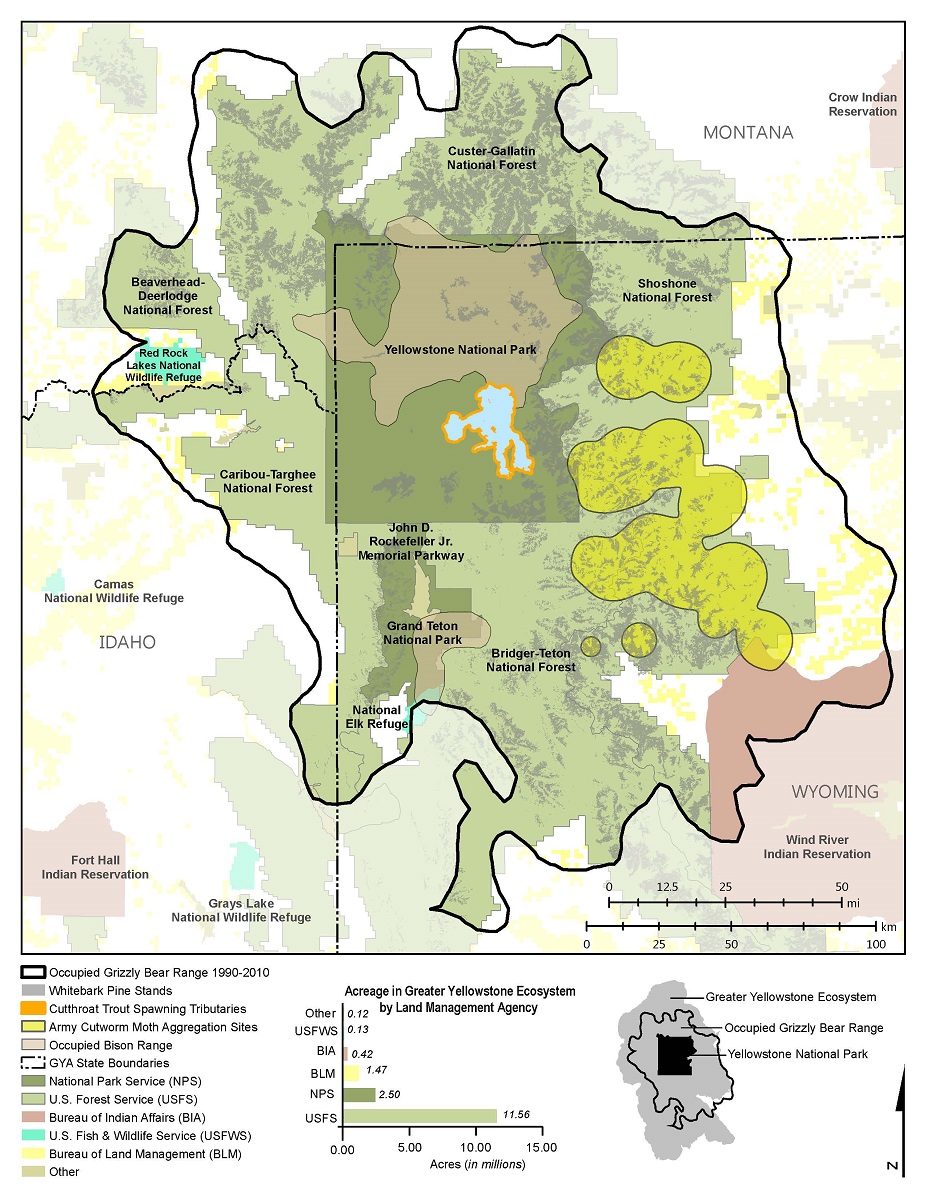
Yellowstone National Park Maps Question and Answers
Where is Bridge Bay Campground on the map? Bridge Bay Campground is a popular camping destination located in the central part of Yellowstone National Park, in the state of Wyoming, United States. To get to Bridge Bay Campground, take the Grand Loop Road and head towards the central section of the park. The campground is situated near the shore of Yellowstone Lake, just north of the West Thumb Geyser Basin. The coordinates for Bridge Bay Campground are approximately 44.5509° N, 110.4148° W. Bridge Bay Campground offers over 400 campsites for visitors, as well as several amenities, including restrooms, showers, and a general store. The campground is situated near several popular attractions, including the West Thumb Geyser Basin, the Fishing Bridge, and the Lake Village area. Visitors can reserve a campsite at Bridge Bay Campground in advance through the park’s online reservation system or by calling the park’s reservation office. The campground is open from late May to early September, and visitors should be prepared for changing weather conditions and wildlife encounters.
Where is Canyon Lodge on the map? Canyon Lodge is located in the northeastern part of Yellowstone National Park, in the state of Wyoming, United States. To get to Canyon Lodge, take the Grand Loop Road and head towards the northeast section of the park. The lodge is situated between the North Rim Drive and South Rim Drive, just south of the Grand Canyon of the Yellowstone. The coordinates for Canyon Lodge are approximately 44.7317° N, 110.4838° W. Canyon Lodge is a popular lodging option for visitors to Yellowstone National Park, offering comfortable accommodations in a convenient location. The lodge features a range of amenities, including restaurants, gift shops, and a general store. It is open from early June to early October each year. From Canyon Lodge, visitors can easily explore the many attractions in the northeast section of the park, including the Grand Canyon of the Yellowstone, the Tower-Roosevelt area, and the Lamar Valley.
Where is Hayden Valley on the map? Hayden Valley is a scenic valley located in the central part of Yellowstone National Park, in the state of Wyoming, United States. To get to Hayden Valley, take the Grand Loop Road and head towards the center of the park. The valley is situated between Yellowstone Lake to the south and Canyon Village to the north. The coordinates for Hayden Valley are approximately 44.6652° N, 110.5409° W. Hayden Valley is a popular destination for wildlife viewing, with a large population of bison and elk inhabiting the area. Visitors can also spot other wildlife such as grizzly bears, wolves, and coyotes. The valley is also home to several scenic viewpoints, including Sulphur Caldron and the Hayden Valley Overlook. Visitors can access Hayden Valley by car or by taking one of the many hiking trails in the area. The valley is easily accessible from many of the park’s major attractions, including the Old Faithful geyser and the Grand Canyon of the Yellowstone.
Where is Lake Yellowstone on the map? Lake Yellowstone is a large lake located in the southeastern part of Yellowstone National Park, in the state of Wyoming, United States. To get to Lake Yellowstone, take the Grand Loop Road and head towards the southeast section of the park. The lake is situated near the Lake Village area, which features several restaurants, gift shops, and lodging options. The coordinates for Lake Yellowstone are approximately 44.4418° N, 110.3264° W. Lake Yellowstone is the largest lake in Yellowstone National Park, spanning over 130 square miles. Visitors can enjoy a variety of activities on the lake, including fishing, boating, and kayaking. The lake is also home to several scenic viewpoints, including the Lake Yellowstone Hotel and the Fishing Bridge. Lake Yellowstone is easily accessible by car, and visitors can park at one of the many pullouts along the lakeshore. The lake is located near several other popular attractions in the southeast section of the park, including the West Thumb Geyser Basin and the Upper Yellowstone Falls.
Where is Lamar Valley on the map? Lamar Valley is a scenic valley located in the northeastern part of Yellowstone National Park, in the state of Wyoming, United States. To get to Lamar Valley, take the Grand Loop Road and head towards the northeast section of the park. The valley is situated east of Tower Junction, along the Lamar River. The coordinates for Lamar Valley are approximately 44.9070° N, 110.3506° W. Lamar Valley is known for its abundant wildlife, including bison, elk, wolves, grizzly bears, and other animals. Visitors can spot wildlife by driving along the Lamar Valley Road, which offers scenic views of the valley and the surrounding mountains. The Lamar Valley area also features several hiking trails, including the Lamar River Trail and the Specimen Ridge Trail. Lamar Valley is accessible by car, and visitors can park at one of the many pullouts along the Lamar Valley Road. The valley is located near several other popular attractions in the northeast section of the park, including the Tower-Roosevelt area, the Grand Canyon of the Yellowstone, and the Yellowstone River.
Where is Madison Campground on the map? Madison Campground is located in Yellowstone National Park, in the state of Wyoming, United States. It is situated in the western part of the park, approximately 14 miles east of the West Entrance. To get to Madison Campground, take the West Entrance Road and continue straight for about 14 miles until you reach the campground. The campground is located on the north side of the road, just before you reach the Madison River. The coordinates for Madison Campground are approximately 44.6436° N, 110.7096° W. Madison Campground is a popular camping destination within Yellowstone National Park, offering easy access to many of the park’s attractions, including the Old Faithful geyser, the Grand Prismatic Spring, and the Norris Geyser Basin. The campground has over 280 sites, with many of them available on a first-come, first-served basis. It is open from mid-May to mid-September each year.
Where is Mount Washburn on the map? Mount Washburn is a prominent mountain peak located in the north-central part of Yellowstone National Park, in the state of Wyoming, United States. To get to Mount Washburn, take the Dunraven Pass Road and head towards the northeast section of the park. The mountain is situated near the Tower-Roosevelt area, just west of the Lamar Valley. The coordinates for Mount Washburn are approximately 44.7934° N, 110.4333° W. Mount Washburn is one of the most popular hiking destinations in Yellowstone National Park, offering spectacular panoramic views of the surrounding mountains, valleys, and wildlife. Visitors can hike to the summit of the mountain via several trails, including the Chittenden Road Trail and the Dunraven Pass Trail. The hike is considered to be moderately strenuous, with an elevation gain of over 1,400 feet. In addition to hiking, visitors to Mount Washburn can enjoy wildlife viewing, including sightings of bighorn sheep, mountain goats, and bears. The mountain is also home to a fire lookout tower, which offers interpretive programs during the summer months. Access to Mount Washburn is limited during the winter months, and visitors should be prepared for changing weather conditions and trail closures.
Where is Old Faithful on the map? Old Faithful is a famous geyser located in the southwestern part of Yellowstone National Park, in the state of Wyoming, United States. To get to Old Faithful, take the Grand Loop Road and head towards the southwest section of the park. The geyser is located near the Old Faithful Visitor Education Center and the Old Faithful Inn. The coordinates for Old Faithful are approximately 44.4609° N, 110.8281° W. Old Faithful is one of the most popular attractions in Yellowstone National Park, known for its frequent and predictable eruptions. Visitors can watch as the geyser shoots a column of boiling water up to 130 feet in the air. The eruptions occur approximately every 60-90 minutes, and the exact timing can be found posted at the geyser or online. In addition to watching Old Faithful erupt, visitors can explore the many trails and boardwalks in the area, which offer scenic views of the geothermal features in the park, including hot springs, mudpots, and other geysers. The Old Faithful area also features several restaurants, gift shops, and lodging options, including the historic Old Faithful Inn.
Where is Thorofare Region on the map? The Thorofare region is a remote area located in the southeastern part of Yellowstone National Park, in the state of Wyoming, United States. To get to the Thorofare region, visitors must hike or ride horseback on the Thorofare Trail, which begins at the South Entrance of the park and travels over 20 miles to the southeast, ending at the Thorofare Ranger Station. The coordinates for the Thorofare Ranger Station are approximately 44.0148° N, 110.1669° W. The Thorofare region is known for its pristine wilderness and abundant wildlife, including grizzly bears, wolves, elk, and bison. Visitors to the area can enjoy backcountry camping, fishing, and hiking, as well as wildlife viewing opportunities. The region is also home to several scenic lakes and rivers, including the Yellowstone River and Yellowstone Lake. Access to the Thorofare region is limited, and visitors must obtain a backcountry permit from the park before embarking on the hike. The trail is considered to be challenging and remote, and visitors should be prepared for primitive camping and rugged terrain.
Where is West Thumb Geyser Basin on the map? West Thumb Geyser Basin is a popular attraction located on the western shore of Yellowstone Lake, in the southern part of Yellowstone National Park, in the state of Wyoming, United States. To get to West Thumb Geyser Basin, take the Grand Loop Road and head towards the southern section of the park. The basin is situated near the Lake Village area, just south of Fishing Bridge. The coordinates for West Thumb Geyser Basin are approximately 44.4158° N, 110.5739° W. West Thumb Geyser Basin is known for its unique thermal features, including geysers, hot springs, and fumaroles, which are all situated in a small, compact area along the lake shore. Visitors can explore the boardwalks and trails throughout the basin, which offer up-close views of the colorful and dynamic thermal features. In addition to the thermal features, visitors to West Thumb Geyser Basin can enjoy the scenic views of Yellowstone Lake and the surrounding mountains. The area is also home to several picnic areas and a visitor center, which offers interpretive programs and exhibits. Access to West Thumb Geyser Basin is open year-round, weather permitting. Visitors should be prepared for changing weather conditions and should exercise caution when exploring the thermal features.
Learn more about Maps
- Topographical Maps: Representation of the physical features of a region or area.
- Contour Maps: Representation of the contours of the land surface or ocean floor.
- Raised Relief Maps: Representation of land elevations with raised features indicating landforms.
- Terrain Maps: Representation of the physical features of a terrain or landmass.
- USGS Topographic Maps: Representation of topographic features and land elevations based on USGS data.
- USGS Historical Topographic Maps: Representation of historical topographic maps created by the USGS.
- Watershed Maps: Representation of the areas where water flows into a particular river or lake.
- Elevation Maps: Representation of land and water elevations with high precision.
- Physical Maps: Representation of physical features of the Earth’s surface such as landforms, oceans, and plateaus.
- Bathymetric Maps: Representation of the topography and features of the ocean floor.
- NOAA Maps: Representation of atmospheric, oceanographic, and environmental data by NOAA.
- Nautical Maps: Representation of the underwater features and depth of an area for navigation purposes.
- Geologic Maps: Representation of the geologic features of an area such as rock types, faults, and folds.
- Satellite Maps: Representation of earth from high-definition satellite imagery.
Contact us today to learn more about our services and how we can help you achieve your goals.
